

The Famous Foods Of Every Japanese Prefecture Make food the center of your trip to Japan
January 29, 2013 • words written by Koichi • Art by Aya Francisco
Since we’re getting ready to pop over to Japan to do some filming, I wanted to do some research on all the famous foods of every area in Japan. Japan’s really into the whole “famous things in each area” thing, and food is no exception. Each prefecture has its own famous food(s) that they’re known for. Might as well know what they are to eat them, right? The hard part is figuring out what all the famous foods are, since there are many and it’s unclear as to what is the most famous food in certain situations.
So, I’ve been doing my research. Because there are so many prefectures and so many famous foods, I’m going to be breaking this article up into two parts. One for North, East, and Central prefectures of Japan, and one for West and South prefectures of Japan. At the end of the second part, we’ll also include a printout that has a map with numbers on all the prefectures corresponding to a list down below it. That way you can print this out, take it with you, and go on a rompy food excursion in Japan.
Each prefecture will be given 3 famous foods with the exception of a few (like Hokkaido, which is really, really big and tasty). While there are many other famous foods in every single prefecture, these are the ones that seemed to be the most famous.
Hokkaido Prefecture’s Famous Foods
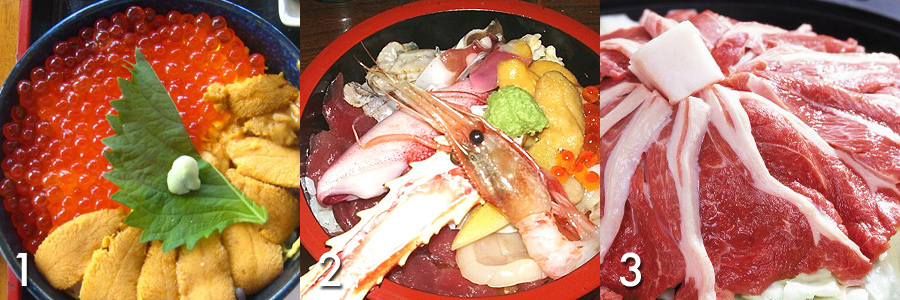
1. Uni, Ikura-don (Sea Urchin and Salmon Roe Rice Bowl) – This is simply a rice bowl that’s one half ikura (salmon roe) and one half uni (sea urchin). They’ve pretty much just combined two of the best seafoods into one donburi, and that makes me hungry.
2. Kaisen-don (Seafood rice bowl) – This is also a rice bowl, but instead of just having two things it has many things. This donburi has many kinds of seafoods on top, which can include crab, shrimp, uni, ikura, salmon, tuna, and more.
3. Jingisukan (Grilled mutton) – This is a yakiniku style dish that’s served on a convex metal skillet or grill. The meat used is lamb which was said to be the meat of choice for Genghis Khan (the dish is named after him), and the skillet is shaped like their helmets which they supposedly cooked their food on.
4. Ishikari Nabe (Salmon and vegetable stew with miso and butter) – This stew is a miso based stew that includes some Hokkaido salmon. Great to eat in the cold Hokkaido winters.
5. Nama Uni Donburi (Raw sea urchin rice bowl) – More rice bowls! This is just donburi that’s all uni all the way. Personally, I’d get #1 because I wouldn’t be able to choose which topping I’d want, but this is a close second.
6. Chan Chan Yaki (Salmon Hotpot) – This is known as the fisherman’s hot pot. It includes salmon and vegetables and comes seasoned in a miso-based sauce.
Aomori Prefecture’s Famous Foods
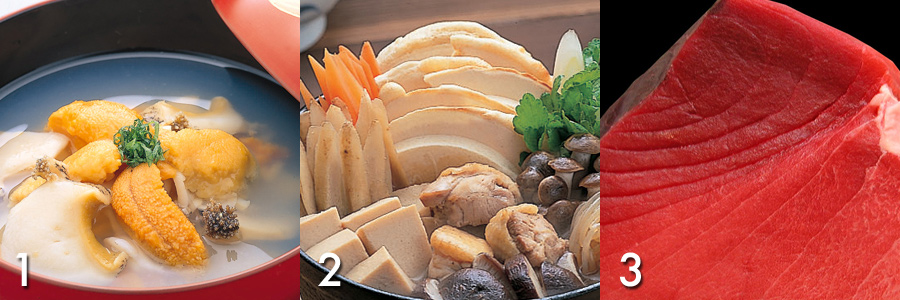
1. Ichigoni aka Strawberry Stew (Sea urchin and abalone stew) – The sea urchin and abalone are boiled in dashi and seasoned with a bit of salt and shoyu (soy sauce). Sounds simple, but also sounds tasty, too. It gets this name not for having strawberries but for being a pinkish color, which is kind of like the color of strawberries.
2. Senbei Jiru (Senbei Soup) – If you’ve never had senbei, you’re missing out. If you’ve never had senbei jiru, well, you ought to try it. It’s probably not like the senbei you’re thinking of though. Senbei jiru tends to use fresh senbei which makes a lot more sense when you consider it’s being put in a soup.
3. Ooma Maguro Tuna Dishes – Ooma is a port known for their tuna. So, this one is getting all grouped together. There are apparently various Maguro Tuna dishes in Ooma Port that are worth trying. If you’re in Ooma, you’ll definitely want to order the tuna.
Iwate Prefecture’s Famous Foods

1. Morioka Reimen (Cold Korean Ramen) – This cold noodle ramen is similar to the North Korean dish Naengmyeon, except the noodles in Japan are made from potato starch. It has a spicy cold beef broth and often includes fruit to help cut the spicy.
2. Morioka Jajamen (Thick Chinese noodles with meat-miso sauce) – These noodles are bigger and more like udon. It’s a Chinese noodle dish that is topped with cucumber, green onion, ginger, a meat-miso sauce and more.
3. Wanko Soba (Small Bowl Soba) – This soba dish is served in small bowls. One theory is because during a festival there wasn’t enough soba to go around, so it was put into smaller bowls so everyone could have a taste. Oh Japan and your small bowls.
Miyagi Prefecture’s Famous Foods

1. Gyuutan Yaki (Roast Cow Tongue) – This is what it sounds like… roast cow tongue. It’s usually sliced in to thin pieces so it’s easier to eat. It’s not like you have to stick the whole cow tongue in your mouth. Moo.
2. Zundamochi (Soy bean mochi / rice cake) – This is basically mochi covered in a soy bean paste. Mochi is good. Soy beans are good. Why not combine them together?
3. Kaki Ryori (Oyster Dishes) – Oyster dishes are well known for in Miyagi Prefecture. So, kind of like Ooma and its maguro, if you see an oyster dish in Miyagi it’s probably worth a try.
Akita Prefecture’s Famous Foods

1. Kiritanpo Nabe (Kiritanpo Hot Pot) – This dish is like… super well known in Akita. It’s a hot pot dish served with kiritanbo, which is made from cooked rice that’s mashed and then formed into cylindars. Many other ingredients are included as well (just as with most nabe) but the kiritanpo is what makes it so well known.
2. Inaniwa Udon – This is a type of udon that’s, well, thin. Normally when you get udon the noodles are thick.
3. Hata Hata Zushi – Known as the “God Fish” for some reason, this fish is a bit sticky and doesn’t have scales. It’s one of those prefecture fishes you’ll mainly find in Akita, though, which probably is why it is kind of famous here.
Yamagata Prefecture’s Famous Foods
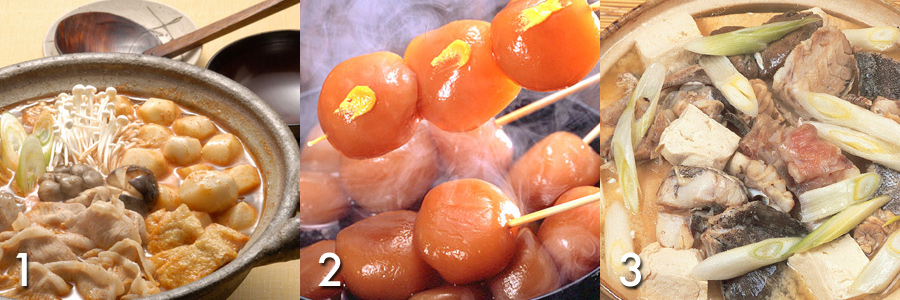
1. Imo Nabe (Potato Stew) – This is essentially a potato nabe. Must be good though since it seems to come in at number one.
2. Tamago Konyaku (Ball Konyaku) – This is konyaku (nearly zero calories!) in the shape of balls, cooked in various ways.
3. Dongara Jiru (Dongara Soup) – This soup contains gray cod cut into large chunks and includes the bones, head and innards. It also includes many other ingredients as well and is a good dish for warming you up in the winter!
Fukushima Prefecture’s Famous Foods

1. Kozuyu – This is a clear soup that contains dried scallop, vegetables, and more. Definitely has a distinct look to it, but looks tasty I think!
2. Kenchin Udon – This is a lot like Kenchin soup (see Ibaraki Prefecture), a soup with lots of roots and vegetables in a tasty broth. Looks like they add udon to theirs, though, making it a bit unique.
3. Nishin no Sanshou Zuke (Pickled Herring) – This is pickled herring that is layered in leaves of sansho and fermented in shoyu, sake, vinegar, and sugar. That way, you can eat it year round!
Niigata Prefecture’s Famous Foods
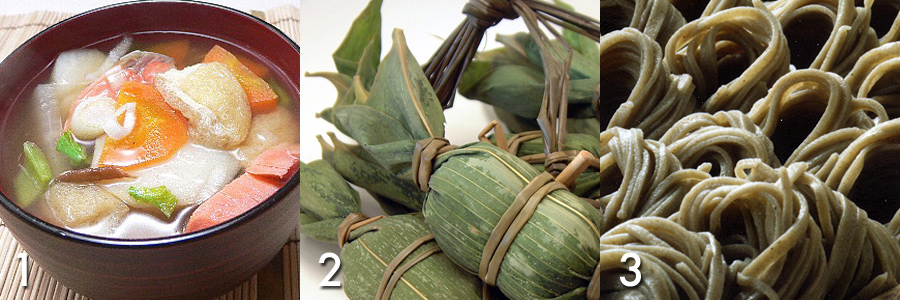
1. Noppei Jiru (Noppei Soup) – This soup is made from leftover vegetable parts cooked in sesame oil. This is often eaten at festivals, Buddhist ceremonies, and during the New Year.
2. SasaDango (Mugwort Flavored Mochi) – This was a portable food back in the Warring States period. It consists of mugwort flavored mochi and redbeans. To make it portable it’s wrapped in bamboo leaves.
3. Hegi Soba – These soba noodles use top-notch buckwheat and are served on a special plate called a “hegi.” The noodles are placed on the hegi so that they can be eaten one mouthful at a time. I like it when people separate my noodles for me so they’re easier to eat. No wonder these are famous.
Toyama Prefecture’s Famous Foods

1. Masuzushi (Trout Sushi) – Okay, when I made fun of sushi abominations a while back, I didn’t realize sushi pizza was an actual traditional thing in Japan. Whoops. Anyways, this salted trout is placed on the rice and then lined with bamboo leaves. It can come in round and not-round varieties.
2. Shiro Ebi Ryori (White Shrimp Dishes) – Toyama is also known for its white shrimp dishes. So, if you’re in Toyama, look out for things that have white shrimp in them.
3. Hotaru Ika Ryori (Hotaru Squid Dishes) – Also popular are Toyama’s Hotaru Squid. They’re little guys and can be cooked in a variety of ways. I like anything that involves Hotaru Ika and sticks, personally.
Ishikawa Prefecture’s Famous Foods

1. Kabura Zushi (Turnip Sushi) – This dish is made from salt preserved turnips and slices of amberjack (along with some other ingredients). It is cured together on malted rice… and here I thought vegetable sushi could never make me hungry.
2. Jibuni (Jibu Stew) – Stewed duck coated in flour, seasonal veggies, and Kanazawa wheat gluten. The “sound of stewing” something is “jibujibu,” which is where this stew got its name.
3. Kaga Ryori (Kaga Dishes) – Any connection to Chairman Kaga? Probably not. Still, #3 is a bunch of dishes bunched into one. This is a style of cooking that uses local seafood, wild greens, and heirloom vegetables. It’s not just one type of dish, though, so you’ll have to catch ’em all if you’re in the Kanazawa City area, where this is popular.
Fukui Prefecture’s Famous Foods
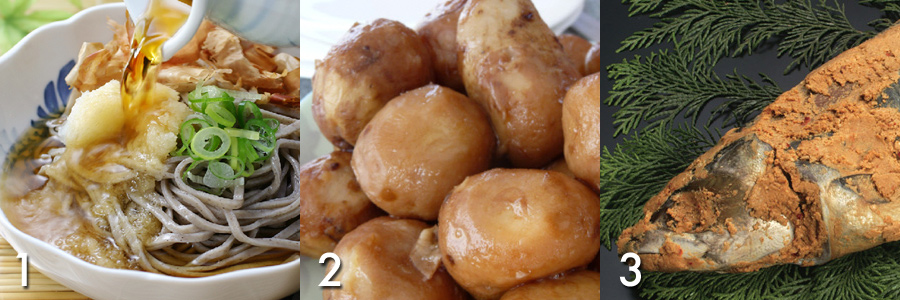
1. Oroshi Soba – This is a cold soba dish that has various toppings on it (unlike zaru soba). This is a good summer meal.
2. Satoimo no Koroni (Sato Potato Stew) – This simple potato dish only has a few ingredients. Sato potatoes, shoyu, sugar, and mirin. But, the simple taste is what makes this one so good.
3. Saba no Heshiko – This is preserved mackerel from Fukui Prefecture. The mackerel are cleaned, salted, and then put in rice bran. These pieces of fish are lightly grilled when it’s eating time.
Gifu Prefecture’s Famous Foods
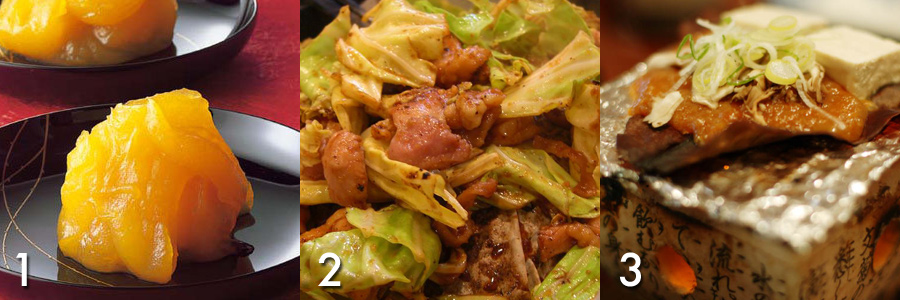
1. Kurikinton (Mashed Sweet Potatoes With Sweetened Chestnuts) – Kuri (chestnuts) and kinton (sweet potatoes). Mush them together and you have Kurikinton. If you eat this you will do well monetarily (because it’s gold in color).
2. Keichan – Cabbage, chicken, and onions in a garlic shoyu marinade. It’s often cooked on a Mongolian skillet, just like jingisukan (see Hokkaido).
3. Hobamiso (Ho Tree Leaf Miso) – These leaves have antibacterial properties, which makes them good for keeping food clean. In this dish, though, you have dried ho leaves. On top, you put miso paste mixed with various other ingredients. It’s then heated over a fire and you eat the stuff on top.
Nagano Prefecture’s Famous Foods

1. Shinshuu Soba – Two parts wheat, eight parts buckwheat. Named after the old name of Nagano prefecture. I didn’t know it was known as the “trustful state.” That’s a good name to have when the Shogun’s watching.
2. Nozawanazuke (Nozawana Pickles) – Nozawana is a Japanese leaf vegetable. This is the pickled variant from Nagano.
3. Oyaki – This is a type of Japanese dumpling made with fermented buckwheat dough wrapped around various toppings. It’s usually steamed or broiled.
Yamanashi Prefecture’s Famous Foods
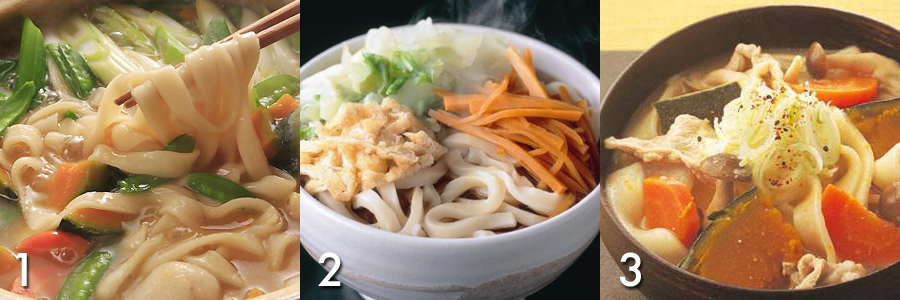
1. Houtou – This is stewed flat udon noodles and vegetables in a soup. The thing that makes this unique is that the udon noodles are prepared in the style of dumplings rather than noodles (which is why locals don’t consider this udon).
2. Yoshida no Udon (Yoshida’s Udon) – This special dish of Fujiyoshida City includes surprisingly firm and thick udon, topped with various ingredients. Each restaurant has it’s own suridane (spices), which means it can vary from place to place. Try the “niku udon.” It has horse meat. Neighhh!
3. Kabocha Houtou (Pumpkin Houtou) – Another houtou (see #1). This time it has Japanese pumpkin.
Aichi Prefecture’s Famous Foods
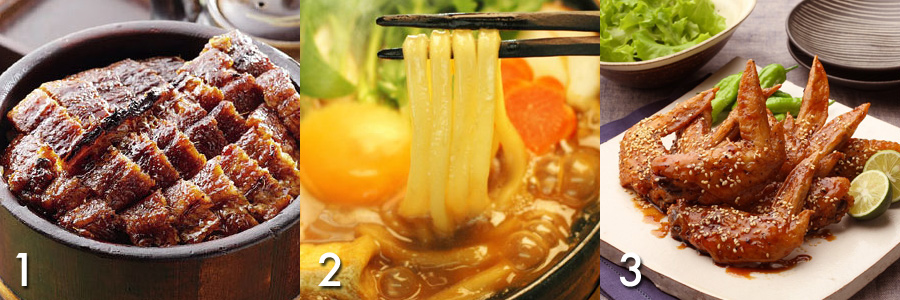
1. Hitsumabushi – This is Aichi style Unagi-don (which is unagi on rice). There is a little difference, though. First you eat the unagi as it is. Then, you add in some seasonings. Finally, when things are breaking up and getting crazy, add dashi (stock) to it and eat it like chazuke.
2. Miso Nikomi Udon – This is a type of udon that’s stewed in a miso broth with various other toppings (like cabbage, onions, carrots, negi, and so on). What a great sounding comfort food.
3. Tebasaki Karaage (Deep Fried Chicken Wings) – I mean, you can’t go wrong with chicken wings, especially if you fry them.
- Bonus: Miso Katsu – I always thought this was really famous, but it only makes it to #4 on the polls. Still, I like it. Aichi loves their miso.
Shizuoka Prefecture’s Famous Foods

1. Sakuraebi Ryouri (Cherry Shrimp Dishes) – If you’re in Shizuoka and you see sakura ebi on the menu be sure to pick it up. There’s many ways to prepare sakura ebi since it’s Shizuoka’s famous food.
2. Unagi No Kabayaki – This is unagi dipped and broiled in a soy based sauce over a grill. I’m a sucker for this.
3. Shizuoka Oden – This is a variet of Oden (various things like boiled eggs, daikon, potatoes, etc., that are first boiled then kept in a simmering broth until eaten). Shizuoka’s version of oden involves beef sinew for the broth and has a strong soy sauce. The broth is then replenished, so the items within get darker and darker and more and more delicious.
Gunma Prefecture’s Famous Foods

1. Yaki Manjuu (Cooked Maju) – This wheat flower that’s been fermented in saké is formed into small dumplings then skewered. On top is a sweet and savory miso-based sauce.
2. Okkirikomi – The most interesting part about this dish is the hand cut noodles, which can get pretty wide. The broth is mirin and shoyu based and includes vegetables, taro, and more.
3. Kamameshi – This is “kettle rice” which is rice that’s eaten from a communal iron pot called a “kama.” It also includes other ingredients besides rice, and the burned rice on the bottom adds an extra wonderful taste.
Tochigi Prefecture’s Famous Foods

1. Shimotsukare – Simmered vegetables, soybeans, abura-age, and sake kasu. Many other additional ingredients can be added as well.
2. Gyouza – You know what gyoza/gyouza is, right? Dumplings, in English. Safe to say, if you’re anywhere the gyoza is pretty good. If you’re in Tochigi, it’s even better. In fact, it’s famous for its gyoza.
3. Chitake Soba – Chitake is a certain kind of mushroom, also known as the Lactarius Volemus. This is a soba dish that features said mushroom.
Ibaraki Prefecture’s Famous Foods
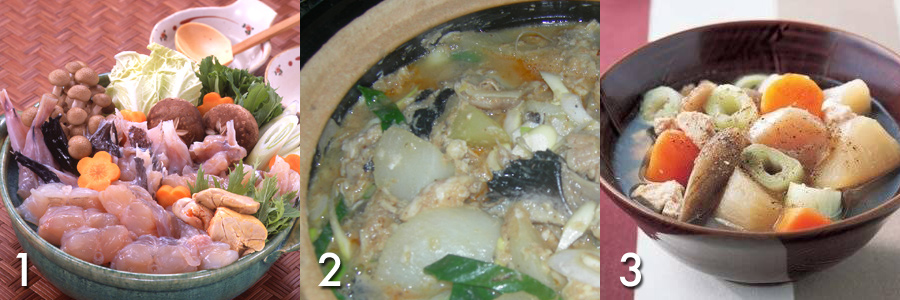
1. Ankou Nabe (Monkfish Stew) – When fresh, the super-ugly monkfish can be pretty good. This stew contains said monkfish, most notably its liver.
2. Ankou no Dobu Jiru (Monkfish ) – Once again it’s the monkfish. Ibaraki’s all about the monkfish. This soup contains all parts of the monkfish, including skin, liver, fins, stomach and more. Don’t waste your monkfish, kids.
3. Kenchin Jiru (Kenchin Soup) – Kenchinjiru is a soup that was first made at kencho-temple (where it got its name). A monk dropped a block of tofu and it broke into many pieces. He put it in the soup anyways, and kenchinjiru was born. The cool thing about this soup is the distribution of the tofu. Since it’s a bunch of little pieces, it’s so even!
Saitama Prefecture’s Famous Foods
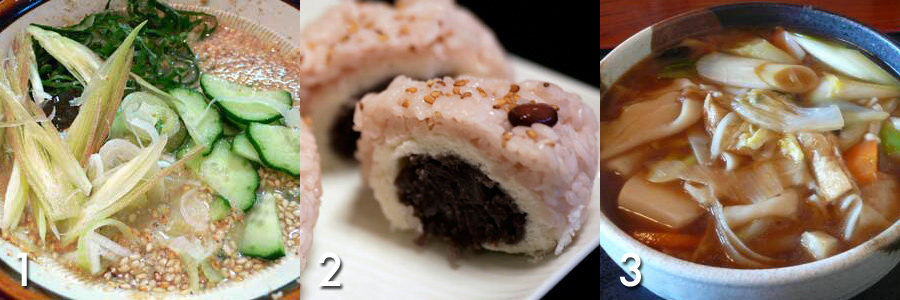
1. Hiyajiru Udon (Cold Soup Udon) – This is a cold-souped udon from Saitama. It has sesame seeds, cucumbers, and other awesome things.
2. Igamanjuu – The rice is cooked with azuki beans and put around a steamed bun with sweet bean jam. Tasty and sweet.
3. Niboutou – This is pretty much the same as Okkirikomi but… Saitama-ified, I guess. Mmmm, Saitama.
Chiba Prefecture’s Famous Foods
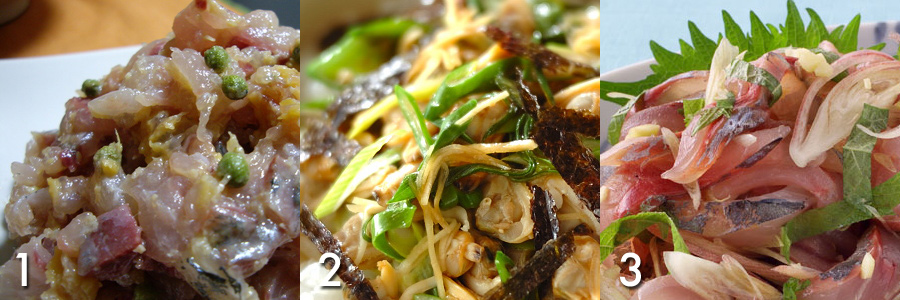
1. Namerou – This is a fisherman’s dish consisting of horse mackerel, sardines, flying fish, and Pacific Saury. It’s cut into small bits and is added to miso, ginger, leeks, and green basil.
2. Yude Rakkasei (Steamed Peanuts) – This area is good for cultivating peanuts, so Chiba and Fuji City have become well known for said peanuts. Apparently these are the only peanuts that go well with alcohol in all of Japan.
3. Aji no Tataki (Minced Horse Mackerel) – This is horse mackerel that has been chopped up and placed with something fresh and tasty.
Tokyo Prefecture’s Famous Foods

1. Monja Yaki – Similar to Okonomiyaki, Monja yaki is a pan-fried batter with various ingredients in it. The difference is mojayaki has more liquid and therefore more runny. It’s then eaten directly off the grill with a spatula.
2. Fukagawa Don (Fukagawa Rice Bowl) – Short-neck clams and hard clams are deep fried and mixed with onions and miso are put on rice. Back in the day these kinds of clams were very plentiful and this dish was popular in Fukagawa. Now it’s just famous.
3. Kusaya – This is a drinking snack consisting of salted and dried fish. It’s super smelly but has a pretty mild taste, all things considered. I wish we would have gotten some of these when we reviewed Japan Crate .
Kanagawa Prefecture’s Famous Foods

1. Kaigun Kare (Navy Curry) – Back in the day Yokosuka had quite the navy base. It still does, though the team that uses it is different. During this time, a type of local curry used with the navy popped up. Strangely, this kind of curry is actually what’s considered “normal” curry in Japan now, though it’s cooked “the old way” here. I suppose it’s famous for birthing curry as Japanese knows it.
2. Namashirasu Don (Raw Whitebait Rice Bowl) – Whitebait is a term for tiny fish, usually baby anchovy or sardines. In this dish, instead of frying or cooking the whitebait fish, you can get it raw. I bet the texture is pretty awesome.
3. Sanmamen – This is a Yokohama style ramen that’s served in a shoyu broth and covered in stir-fried vegetables.
Mie Prefecture’s Famous Foods
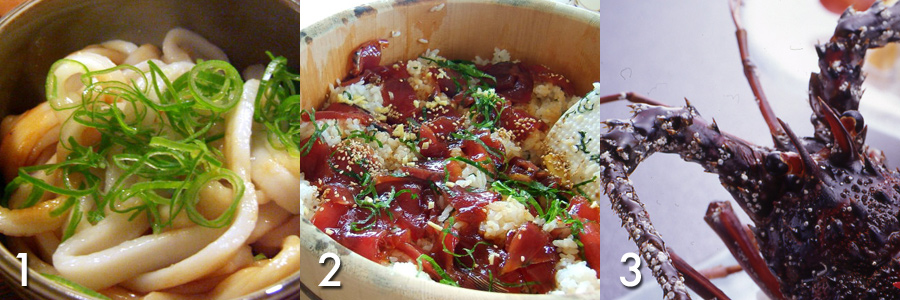
1. Ise Udon – Concentrated soy sauce and sweet cooking sake are used to make a broth that goes over thick udon noodles.
2. Tekonezushi – Supposedly taught to a fisherman by Kobo Daishi. Bonito and sushi rice go together to create this concoctions.
3. Ise Ebi Ryouri (Ise Lobster Food) – If you run into ebi in Ise, it’s probably good.
Shiga Prefecture’s Famous Foods
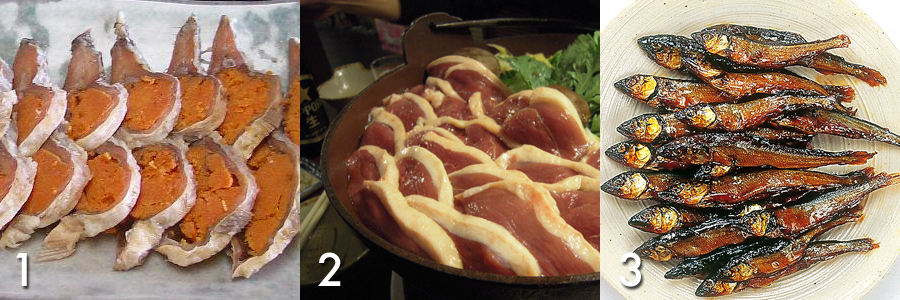
1. Funazushi – Buna (Crucian Carp) is packed in salt for a year and then dried and mixed with rice. This mixture’s then fermented another three years. Mmm, delicious.
2. Kamo Nabe (Duck Hot Pot) – This is what it sounds like. Duck (yum) in a hot pot with other ingredients. It’s the duck that makes it good, though.
3. Ayu No Tsukudani – This is baby sweetfish cooked in sweet soy sauce. Goes well with alcohol, I’d imagine.
Kyoto Prefecture’s Famous Foods

1. Kaiseki Ryori (Traditional Multi Course Dinner) – This isn’t necessarily just one dish, but many. In fact, that’s what this is type of food is all about. It’s the traditional Japanese multi course dinner, which comes with multiple courses, duh.
2. Kyou Tsukemono (Kyoto Pickles) – These are pickles made in Kyoto. They’re known for their simplicity and come in other varieties.
3. Obanzai – Sea vegetables, eggplants, herring, codfish, salted mackerel, tofu, and boiled daikon.
Osaka Prefecture’s Famous Foods

1. Okonomiyaki – This is a kind of savory pancake with various ingredients, like shredded cabbage, pork belly, octopus, squid, shrimp, other vegetables and other things. We wrote a very controversial article (not really) about it.
2. Takoyaki – These round shaped nom noms are made with a wheat flour based batter and filled with other delicious things, most notably the tako (octopus), but also ginger, green onion, and more. One of the most delicious things in the world.
3. Kitsune Udon (Fox Udon) – This is udon topped with aburage.
Hyogo Prefecture’s Famous Foods

1. Akashiyaki – Small round dumpling from the city of Akashi. The batter is made from egg and octopus and is dipped into a dashi before eating.
2. Kobe Beef – This shouldn’t need any explanation as it’s famous world wide. Massage those cows and feed them beer. Mmm, nom.
3. Ikanago no kukini – Ikanago are small fish. Then, they’re taken and cooked in soy sauce, ginger, mirin, and sugar to turn it into this dish. Eat it with rice and alcohol, it’ll be good.
Nara Prefecture’s Famous Foods

1. Kaki no Ha Zushi – This is a pressed sushi using slices of mackerel. They’re wrapped in persimmon leaves because of their antibacterial properties.
2. Miwa Soumen – This is just somen, but it’s from Miwa which is particularly famous for making somen, so, that means it’s pretty good.
3. Yamato no Chagayu – This is a kind of rice gruel that is apparently very Japanese, or very old. Not sure which. Probably old, considering it’s Nara Prefecture.
Wakayama Prefecture’s Famous Foods
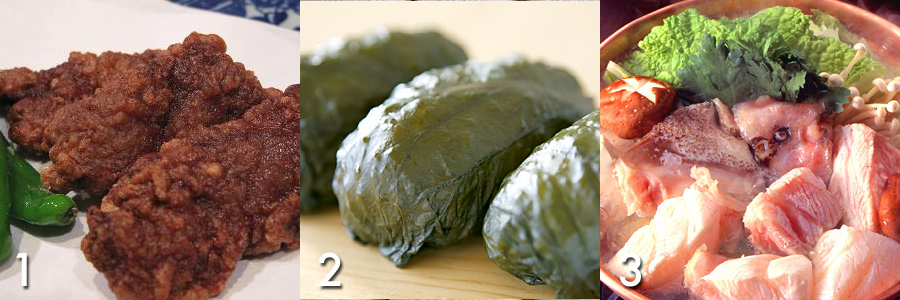
1. Kujira no Tatsuta Age (Deep Fried Whale) – This is battered and deep fried whale meat. So, if eating whale makes you queezy you’ll want to avoid this one.
2. Meharizushi – A rice ball covered with a pickled takana leaf (mustard leaf). The pickled taste and the onigiri (rice ball) go nicely together.
3. Kue Nabe – This is a nabe made from the longtooth grouper (kue). It includes other nabe-ish ingredients too.
Tottori Prefecture’s Famous Foods

1. Matsubagani Ryouri – The Matsubagani is the “snow crab.” It has super long arms and is super tasty. If you’re in Tottori you’ll want to try Matsubagani no matter how it’s prepared.
2. Kanijuu (Crab Soup) – More crab! This time in a soup.
3. Oyama Okowa – This rice is soaked for a night and then cooked with various tasty things. Seems like a nice and filling meal.
Shimane Prefecture’s Famous Foods
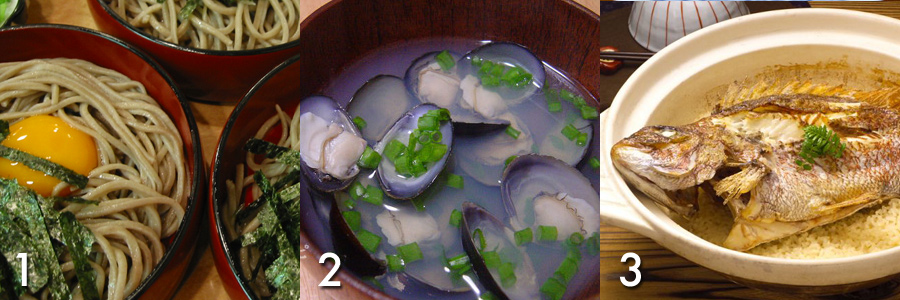
1. Izumo Soba – This is Izumo’s style soba. The interesting part about this soba is that the grains are ground with the husks still on making the taste different (and probably making it better for you). Another thing that makes it different is you pour the sauce on the soba instead of dipping the soba in the sauce.
2. Shijimi Jiru – Shimiji clamsin broth, seasoned with soy sauce / miso. Clamtastic, this one is.
3. Taimeishi – Tai, the dumbest fish in the sea ( or restaurant ). Shimane is known for its Tai-rice dish where the tai is put together with the rice. Looks just about perfect.
Okayama Prefecture’s Famous Foods
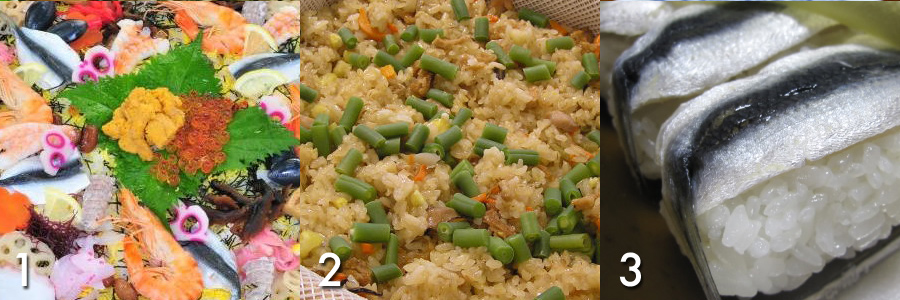
1. Okayama Barazushi – Rich, fresh seafood and vegetables on top of sushi rice. Looks pretty.
2. Hiruzen Okowa – Steamed rice with red beans. Supposedly this dish came about when someone accidentally mixed the red beans with the rice thinking it was something else. What a nice mistake.
3. Mamakari Zushi – The mamakari is of the sardinella family and in this case is made into sushi. Though, Okayama is somewhat known for its non-sushi mamakari sushi dishes too.
Hiroshima Prefecture’s Famous Foods

1. Hiroshima Okonomiyaki – The difference with Hiroshima’s Okonomiyaki is that instead of mixing the ingredients you layer them, making things a bit taller, especially considering you use 3-4 times the amount of cabbage. It’s like Okonomiyaki x4.
2. Kaki Ryouri (Oyster Cooking) – If you’re in Hiroshima, get something with oysters. It’ll probably be good.
3. Anago Meshidon (Eel Rice Bowl) – Conger eel on top of rice. Looking good, eel.
Yamaguchi Prefecture’s Famous Foods

1. Fugu Ryouri (Blowfish Cooking) – Feel like putting your life on the line? Have some blowfish. It’s well known in Yamaguchi, so if you are going to do it anywhere might as well be here.
2. Fugu Sashi (Fugu Slices) – This is just thinly cut sashimi. Probably my favorite way to have fugu.
3. Shirouo Ryouri (Ice Goby Cooking) – The Ice Goby is a tiny little fish. Yamaguchi Prefecture is known for cooking them well.
Tokushima Prefecture’s Famous Foods
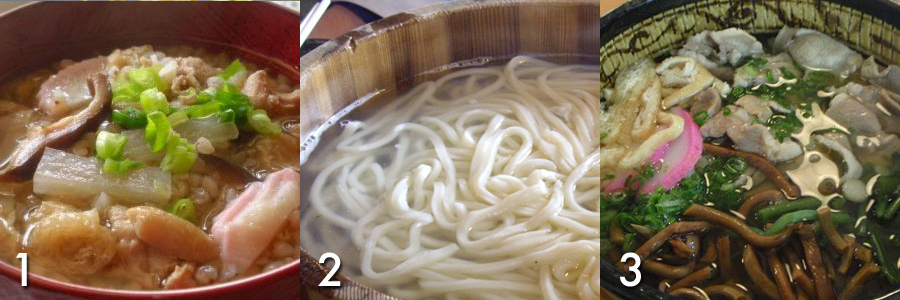
1. Sobagome Zosui – This is buckwheat grain that has been made into a thick porridge. Since rice isn’t suitable to grow in this region buckwheat is pretty big. This porridge is served with various toppings and ingredients.
2. Tarai Udon – This is udon that’s placed into a wooden basin filled with hot water. Take the udon out and dip it into the dipping sauce, kind of like you’d do with soba, but this is udon!
3. Iya Soba – Iya is a district of Tokushima, and here they make soba that’s put in soup broth of iroko along with other ingredients on top.
Kagawa Prefecture’s Famous Foods

1. Sanuki Udon – Sanuki is what Kagawa Prefecture used to be named, so this is basically “Kagawa Udon.” With Sanuki udon, you usually have udon noodles served al dente with a broth of tuna + kelp.
2. Shippoku Udon – This is udon prepared with lots of vegetables, often served in Winter. The vegetables are boiled first then put on the noodles as toppings. Sounds very healthy.
3. Iriko Meshi – This is sardine put on top of and cooked with rice. Sounds like a match made in heaven, to be honest.
Ehime Prefecture’s Famous Foods

1. Uwajima Tai Meshi – This is a rice dish made with Tai that’s served in the Uwajima district of Ehime. If you’re in Uwajima be sure to look out for this one.
2. Jakoten – This cake is made from small fish that are blended into a paste and then fried. Basically, this is a fish cake made from Hotarujako, a small white fish, though it’s hard to notice that when they’re blended into a cake.
3. Satsuma-jiru – This is a miso-flavored pork and vegetable stew / soup.
Kouchi Prefecture’s Famous Foods

1. Katsuo no Tataki – This is seared bonito that has been sliced. Apparently it’s good raw, but very good seared. It’s eaten with grated ginger (and other things as well, depending on your location).
2. Sawachi Ryouri – Traditionally this consisted of sashimi and sushi, but recently other types of food have been included as well. Basically, this is a bunch of food served on a huge plate (called a sawachi). You can see that from the image above.
3. Katsuo no Tosazukuri – This is another version of #1, Katsuo no Tataki. They’re both pretty similar, possibly the same, but you should eat both anyways.
Fukuoka Prefecture’s Famous Foods

1. Mentaiko – This marinated roe of pollock. This originally came from Korea, though apparently the Japanese version is a little different. It actually was nominated as Japan’s number one side dish in the Shuukan Bushun back in the day, apparently.
2. Motsu Nabe – This nabe dish is made from beef or pork offal, which is usually beef intestines.
3. Tori no Mizutaki – This is another nabe dis, this time vegetables and chicken.
Saga Prefecture’s Famous Foods

1. Yobiko no Ika Ryouri (Yobiko Squid Cooking) – Yobiko is a town in Saga Prefecture. They apparently make good squid. Eat said squid and enjoy.
2. Mutsugurou no Kabayaki (Charcoaled Mudskipper) – This is what it sounds like, charcoaled mudskipper. What’s a mudskipper, you ask? Well, that’s a wetlands fish that is amphibious and can walk on land using its fins. No wonder they eat these. It’d be terrifying if their population got out of control.
3. Dagojiru – this is a soup that has noodles, chicken, and many kinds of vegetables in it. A good, healthy energy boosting dish, especially in winter, I’d imagine.
Nagasaki Prefecture’s Famous Foods

1. Sara Udon / Chanpon – Literally “plate” udon, this is when you put a base of noodles on a plate, then cover them with cabbage, bean sprouts, other vegetables, squid, prawns, pork, and other things. If you use thicker noodles it’s called Chanpon, but they’re very similar besides that.
2. Shippoku Ryori – This is a type of cooking that comes from traditional formal banquets in ancient China. Circular tables are arranged with Japanese and Chinese delicacies, as well as foods introduced by European traders. Remember, Nagasaki was the only contact Japan had with the outside world for a long time, so it has lots of international influence!
3. Sasebo Burger – This is a handmade burger from Sasebo. This recipe came from the American navy and was handed down to Japan where it eventually became famous. Apparently these burgers are very good though I have yet to try one. Even though you’d think there’s no reason to eat hamburgers in Japan, this may be one situation where the rules don’t apply.
Kumamoto Prefecture’s Famous Foods
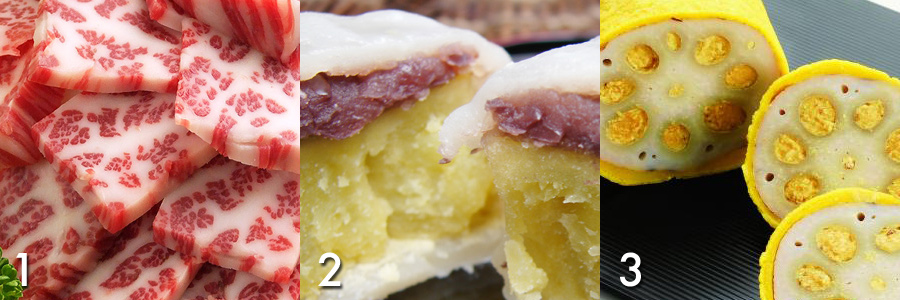
1. Basashi – Sliced horse. Yes, you can eat horse sashimi in Japan.
2. Ikinari Dango – Steamed bun with chunks of sweet potato in the dough. Inside is anko (red bean paste).
3. Karashirenkon (Mustard Lotus Root) – Karashi is a type of spicy mustard. Renkon is lotus root. Put them together and… you have karashirenkon! Make sure you slice it up before eating it. Don’t eat it like a hotdog.
Oita Prefecture’s Famous Foods

1. Buri no Atsumeshi – Slices of raw yellowtail that have been marinated in a soy sauce / sugar / vinegar / sake mixture are served over hot rice. Also included are things like green onion, nori, and sesame seeds.
2. Gomadashi Udon – This is fish that is grilled the crushed and mixed with soy sauce and sesame seeds. It’s then put over udon.
3. Tenobe Dango Jiru – These are hand stretched dumpling noodles served in a savory soup.
Miyazaki Prefecture’s Famous Foods
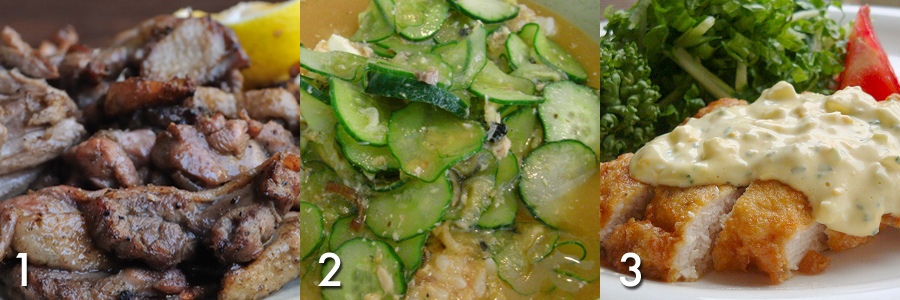
1. Miyazaki no Sumibiyaki – This is chicken meat that’s cut up and grilled over charcoal until black. The charred taste is what makes this one good. It also probably gives you stomach cancer.
2. Hiyajiru – Small fish are grilled and crushed then blended with sesame seeds and miso. It’s then put in a soup with cucumber and cucumber.
3. Chicken Nanban – This is a Kyushu style fried chicken that’s been briefly marinated in a sweet-sour-salty-spicy sauce called nanban sauce (thus the nanban).
Kagoshima Prefecture’s Famous Foods

1. Tori Meshi – This is chicken rice with various things on top of it.
2. Kibinago Ryouri – This is a small silver fish that lives off of Kagoshima. There are many ways to eat it, but the most common looks to be as sashimi along with a miso dip. Other ways include grilled, simmered, deep-fried, and in soups.
3. Tonkotsu Ryouri – Tonkotsu is pork that is cooked very slowly so it can be soft. It’s pretty much delicious in everything as Kagoshima has also figured out.
Okinawa Prefecture’s Famous Foods

1. Soki Soba – This is a soba that is served with stewed pork spare ribs with the cartilage attached.
2. Goya Chanpuru – This consists of tofu combined with vegetables, meat, or fish (and sometimes spam!). Bittermelon seems to be a very common vegetable here.
3. Rafutee – Pork belly that’s tender, succulent, and a lot like bacon… but better. It’s seasoned with a ginger broth, awamori, and water. Basically, it’s delicious, and like bacon, kind of.
Get The “Famous Foods Of Every Japanese Prefecture” Cheat Sheet!
I’ve also put together a cheatsheet for you. There's a pretty version, a printable version, and a text version so that way you can print it out or put it on your phone. Basically, no matter where you go in Japan you’ll now know what you should be eating, because that’s kind of important. Click the links below to get these cheatsheets:
- Pretty Color Cheatsheet
- Black and White Cheatsheet
- Text File Cheatsheet
There you have it. I hope you didn’t read this right before lunch or dinner, because that would be cruel and unusual punishment. Enjoy the cheat sheets and tell us about all the great food you end up eating / have already eaten, because if there’s one thing the internet needs more of its people posting things about food.
Tokyo Food Safari: Exploring Street Food and Iconic Dishes

Popular Street Food Spots in Tokyo
Must-try street foods in tokyo, iconic dishes of tokyo you must try, unique dining experiences in tokyo, frequently asked questions.
Welcome to the gastronomic world of Tokyo, a city that boasts an unparalleled culinary scene. From sizzling street food stalls to Michelin-starred restaurants, Tokyo is a vibrant food safari where traditional dishes meet innovative cuisine. With more than 150,000 restaurants, Tokyo holds the record for the most Michelin stars in the world , underscoring its status as a food lover's paradise. In this blog post, we'll take you on a tantalizing tour through Tokyo's iconic dishes and hidden street food gems.
The essence of Tokyo's food culture lies in its diversity and commitment to quality. Whether it's the precision of sushi masters at Tsukiji Fish Market or the soul-warming bowls of ramen found in back alley noodle shops, each dish tells a story of tradition, passion, and craftsmanship. Today we'll explore the unique flavors of Tokyo, from the sweet allure of mochi to the savory delight of yakitori, and experience the city's dynamic food scene that seamlessly blends the old with the new.
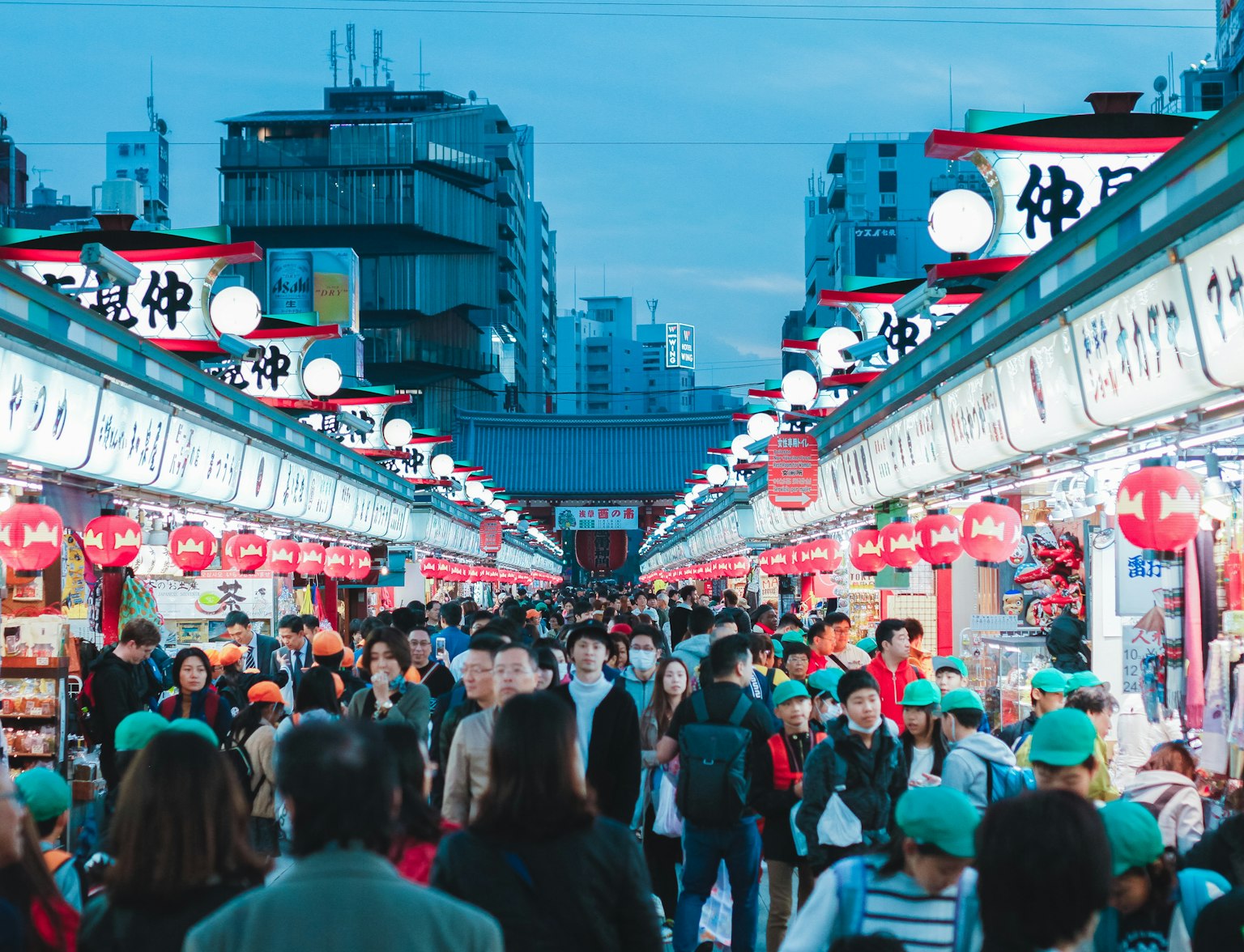
The Asakusa Food Hunt Cultural Tour is a 2-hour guided experience that explores the non-touristy part of Asakusa, visiting local food vendors and providing an authentic taste of Japanese culture.
Tokyo's street food culture is a vibrant blend of traditional flavors and innovative culinary creations. The city's bustling streets and markets offer an array of delicious options that cater to both locals and visitors.
Tsukiji Outer Market
The Tsukiji Outer Market , located in central Tokyo, is a paradise for seafood lovers. Home to about 400 shops, this bustling marketplace offers a wide variety of fresh seafood, vegetables, and traditional Japanese food materials. Here, you can savor succulent slices of sashimi, slurp up a bowl of ramen brimming with seafood, or enjoy a hearty seafood donburi, a rice bowl topped with a medley of fresh seafood.
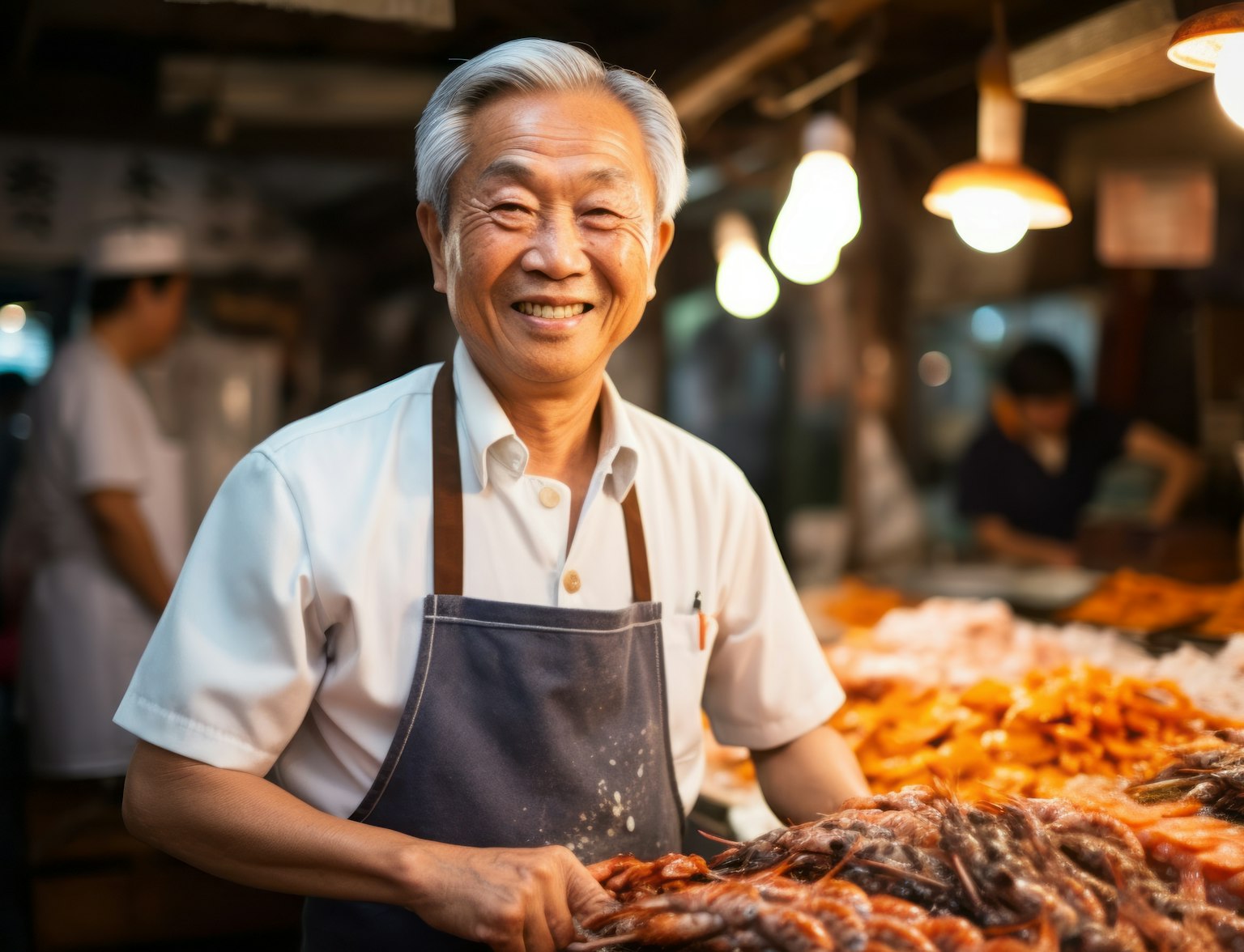
Dive deep into Tokyo's culinary heart with a journey through the lively Tsukiji Market.
But it's not just about seafood at Tsukiji. The market also boasts a range of other culinary delights. You can find stalls selling Japanese pickles, wasabi, dried seaweed, and other traditional food ingredients. For dessert, indulge in some Japanese sweets like matcha ice cream or mochi.
Ameya-Yokocho (Ueno)
Ameya-Yokocho, often referred to as "Ameyoko", is a lively market street in Ueno. This bustling open-air market is known for its wide variety of street foods that cater to all kinds of palates. From fresh seafood to traditional Japanese sweets, Ameyoko offers a smorgasbord of flavors that will leave you wanting more.
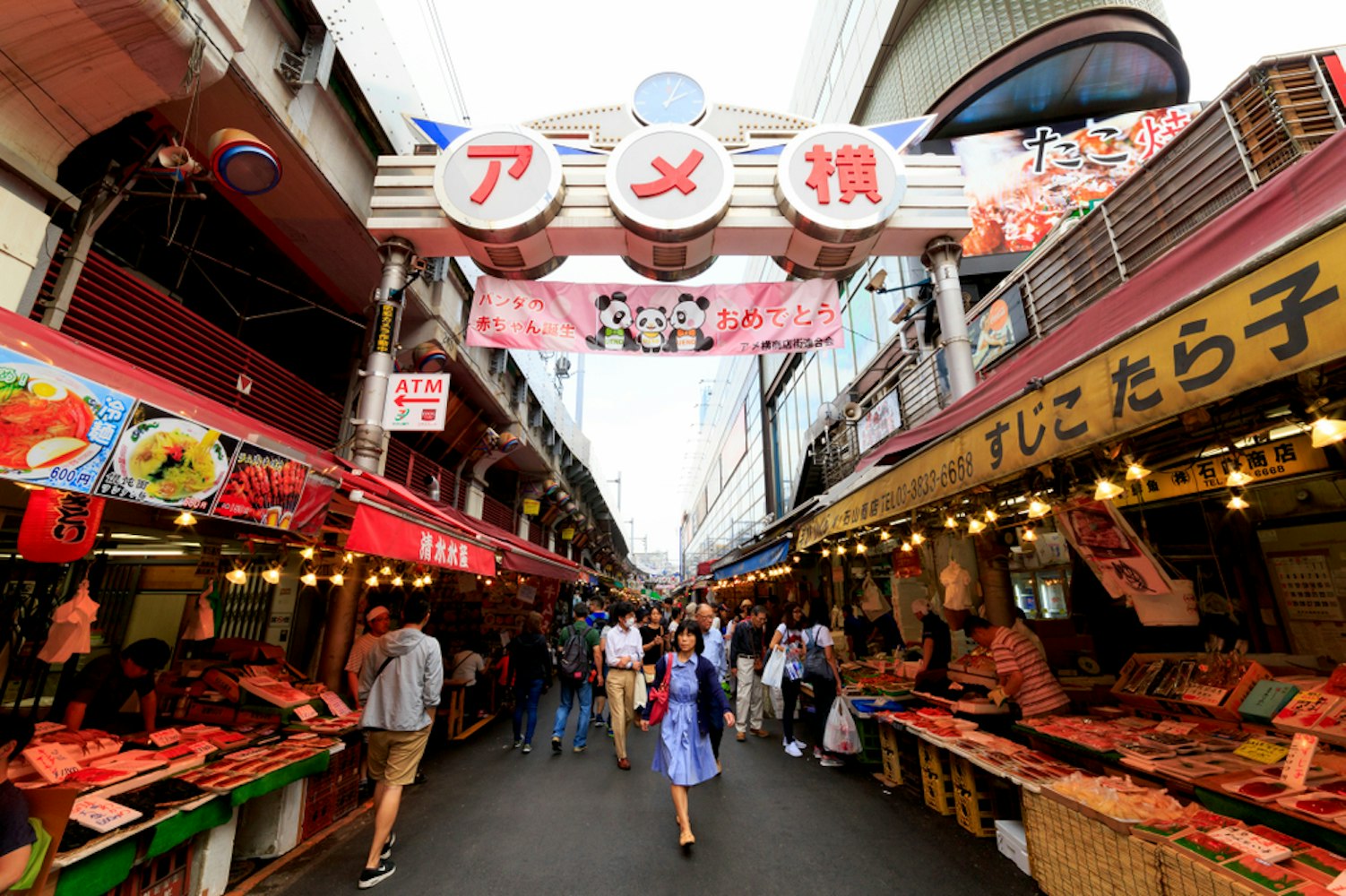
One of the must-try street foods here is Tamagoyaki , a sweet and fluffy Japanese rolled omelet that is often enjoyed as a breakfast dish or a side dish for sushi. Another crowd favorite is Menchi Katsu, a breaded and deep-fried ground meat patty that's crispy on the outside and juicy on the inside. Walking through the narrow lanes of Ameyoko, you'll be enveloped by the enticing aroma of these delicious treats, making it an unforgettable gastronomic experience.
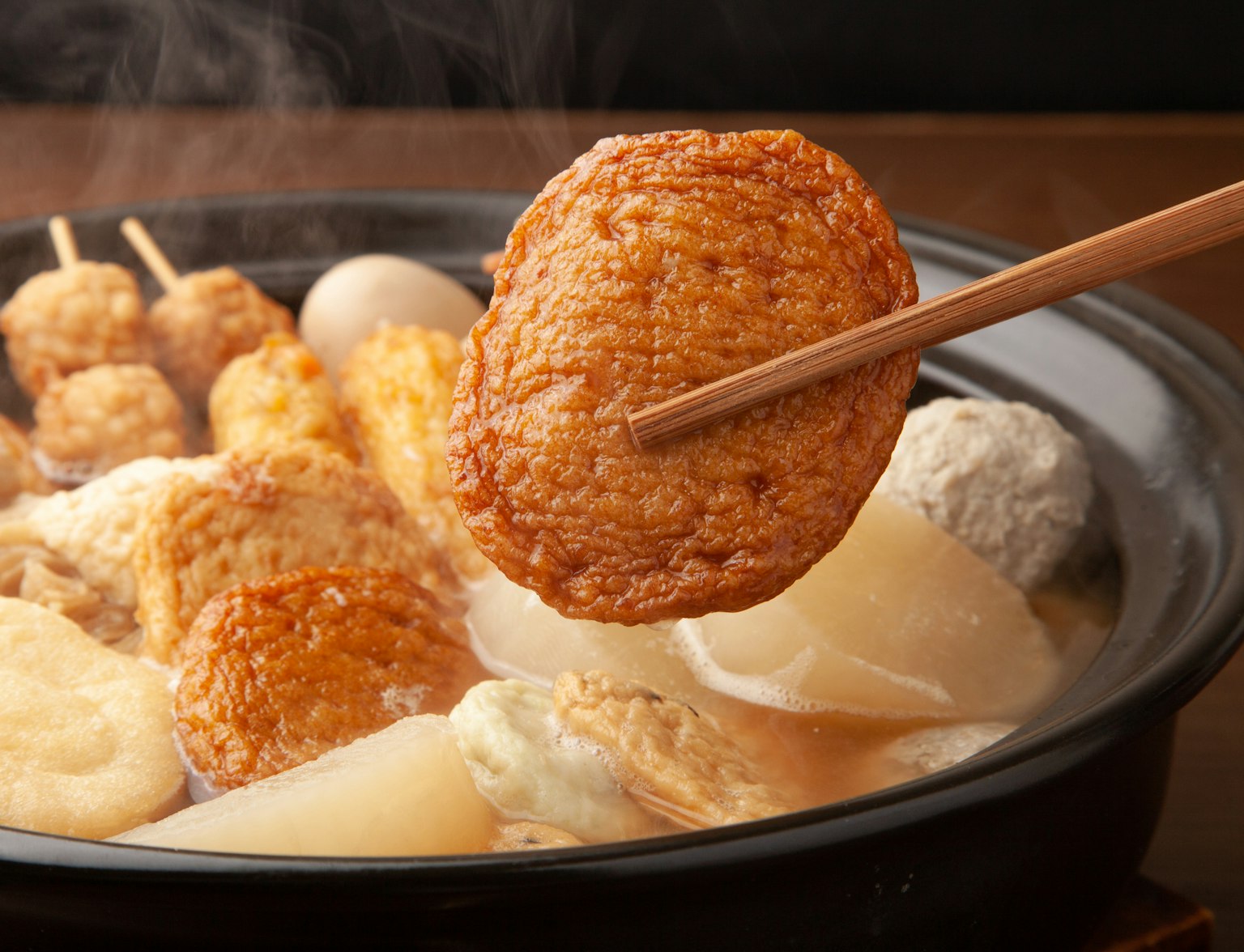
Ready to explore the exciting world of Japanese cuisine? Join our Tokyo food tour to discover the city's hidden culinary gems and the fascinating stories behind the foods we eat.
Takeshita Street (Harajuku)
Takeshita Street, located in the trendy district of Harajuku, is a mecca for foodies and fashion enthusiasts alike. This pedestrian-only street is famous for its quirky shops, themed cafes, and most importantly, its unique street food offerings.
Takeshita Street is best known for its colorful and Instagrammable desserts. Crepes are a big hit here, with shops offering a myriad of fillings ranging from fresh fruits to whipped cream and even whole slices of cheesecake.
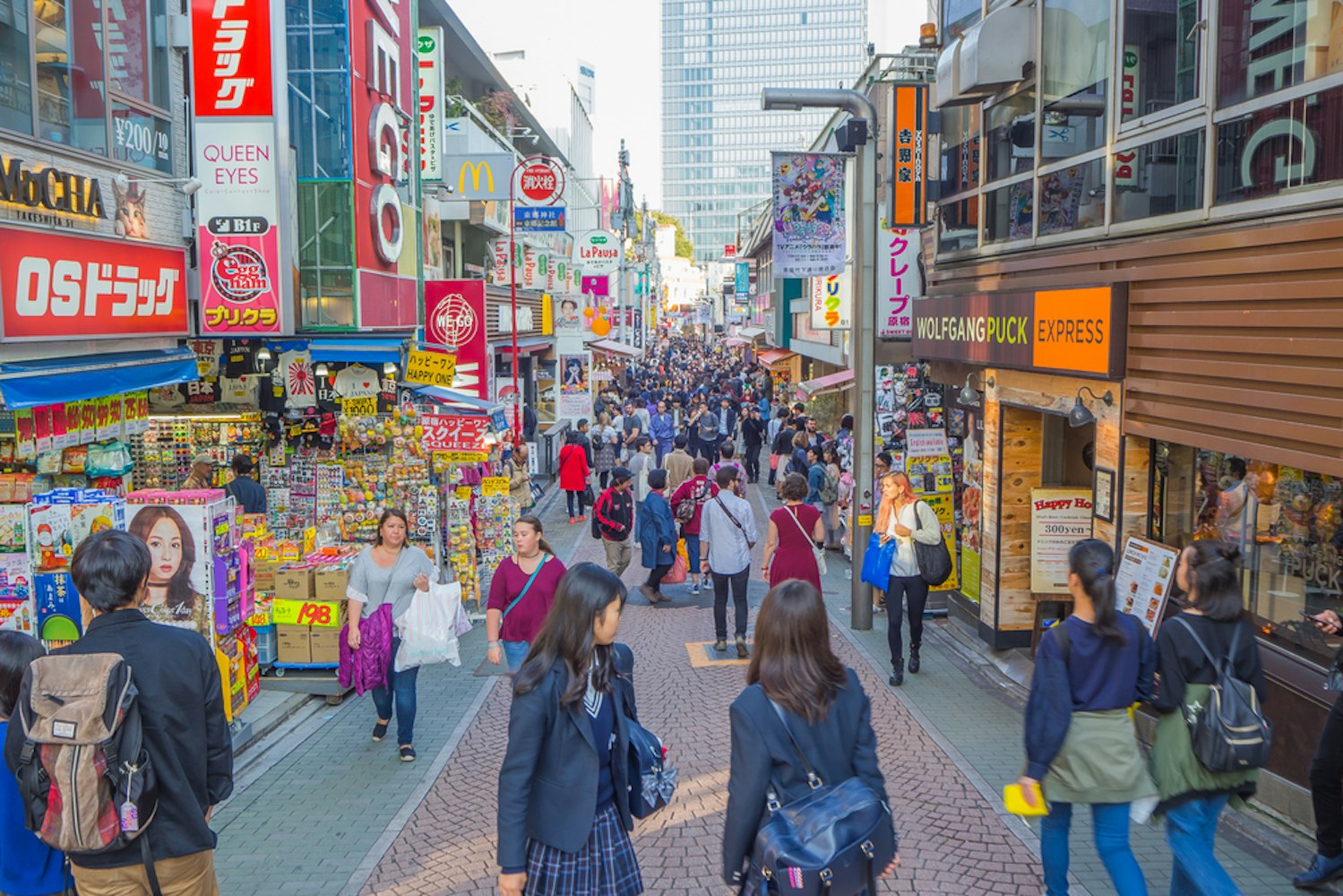
Another popular treat is the cotton candy, which comes in a rainbow of colors and is as big as your head! For those with a more adventurous palate, there's Harajuku Gyoza Lou, a popular dumpling shop that serves some of the best gyoza in Tokyo.
Nakamise Shopping Street (Asakusa)
Nakamise Shopping Street is one of the oldest shopping areas in Japan and is located on the approach to Senso-ji Temple in Asakusa. This bustling street is lined with over 90 shops that offer a variety of traditional Japanese snacks and souvenirs.
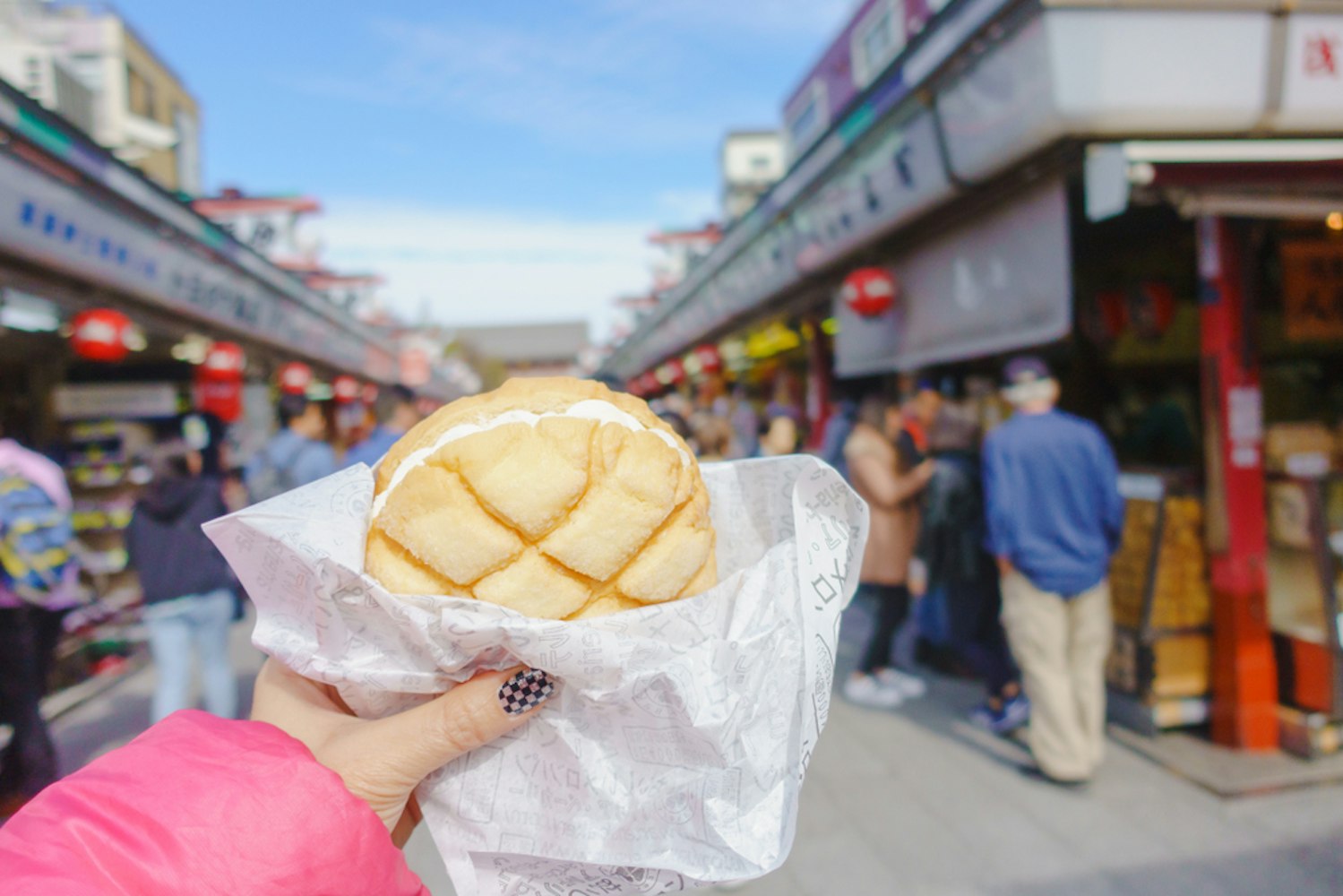
Here, you can find classic Japanese street foods like Dango, a skewer of sweet dumplings made from rice flour, and Ichigo Daifuku, a soft mochi filled with sweet red bean paste and a whole strawberry.
Another must-try is the Unagi Skewer, grilled eel served on a stick, which perfectly balances sweet, savory, and smoky flavors. Nakamise Shopping Street offers a taste of Tokyo's rich culinary history, making it a must-visit for any food lover.
Memory Lane (Omoide Yokocho) in Shinjuku
Memory Lane, also known as Omoide Yokocho or "Piss Alley", in Shinjuku, is a narrow alleyway lined with tiny bars and food stalls. This nostalgic spot provides a glimpse into Tokyo's past, with its old-world charm and Showa-era ambiance. Here, you can experience the traditional izakaya culture , enjoying skewers of yakitori (grilled chicken) with a cold beer in hand.
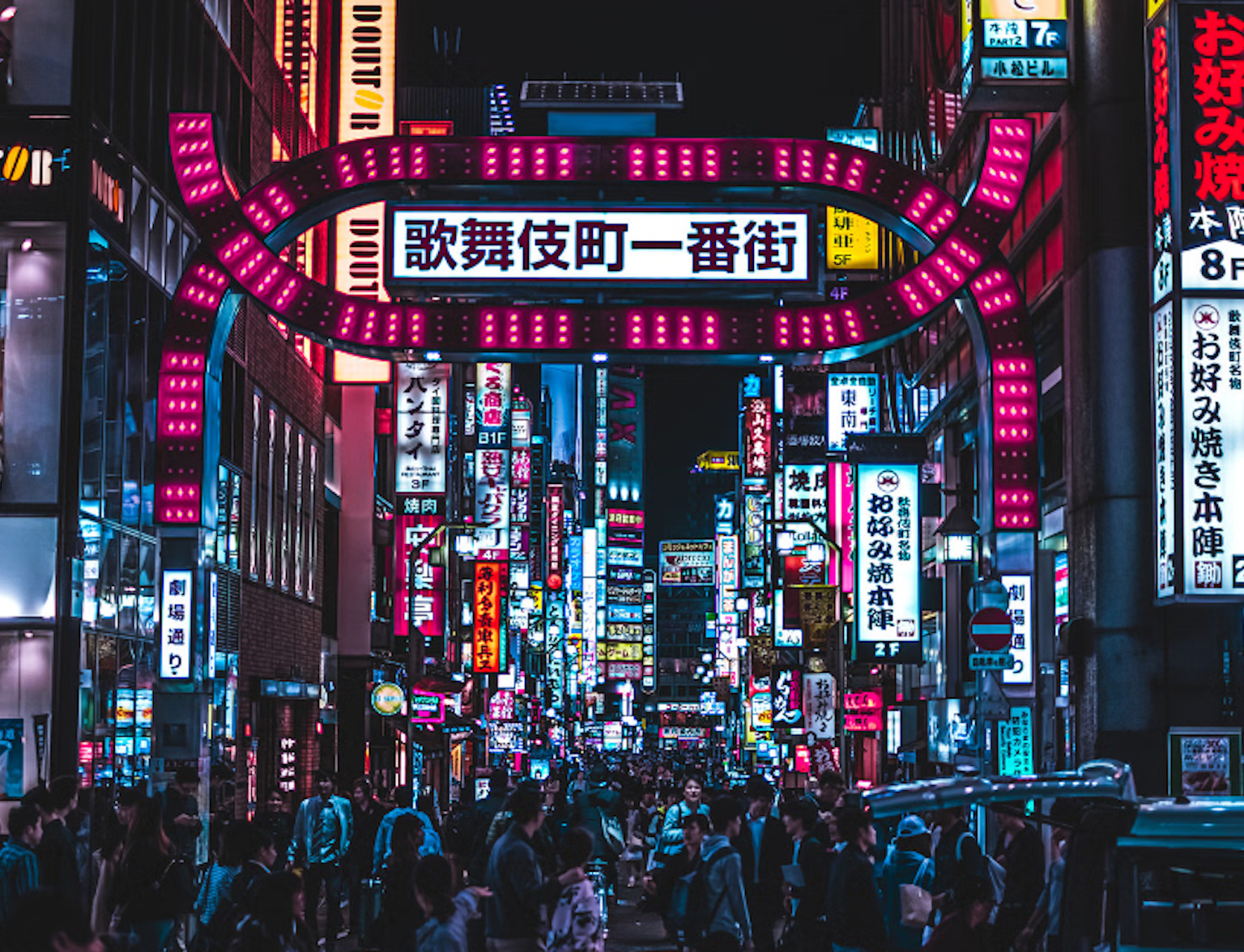
Embark on a mesmerizing Shinjuku nightlife tour, which includes a visit to Memory Lane.
The food stalls in Memory Lane offer an array of dishes that go beyond yakitori. You can find stalls serving up sizzling hotplates of gyoza (Japanese dumplings), bowls of ramen, and even unusual delicacies like grilled salamander. Despite its size, the alley is packed with flavor, making it a must-visit spot for adventurous foodies.
Tokyo is a gastronomic paradise, offering a diverse range of street foods that reflect the city's vibrant food culture. Yakitori, skewered and grilled chicken, is a staple street food that pairs perfectly with a cold beer. Takoyaki, a savory snack filled with diced octopus, is another must-try. It's cooked in a special molded pan and usually served with a variety of toppings like mayonnaise, green laver, and bonito flakes.
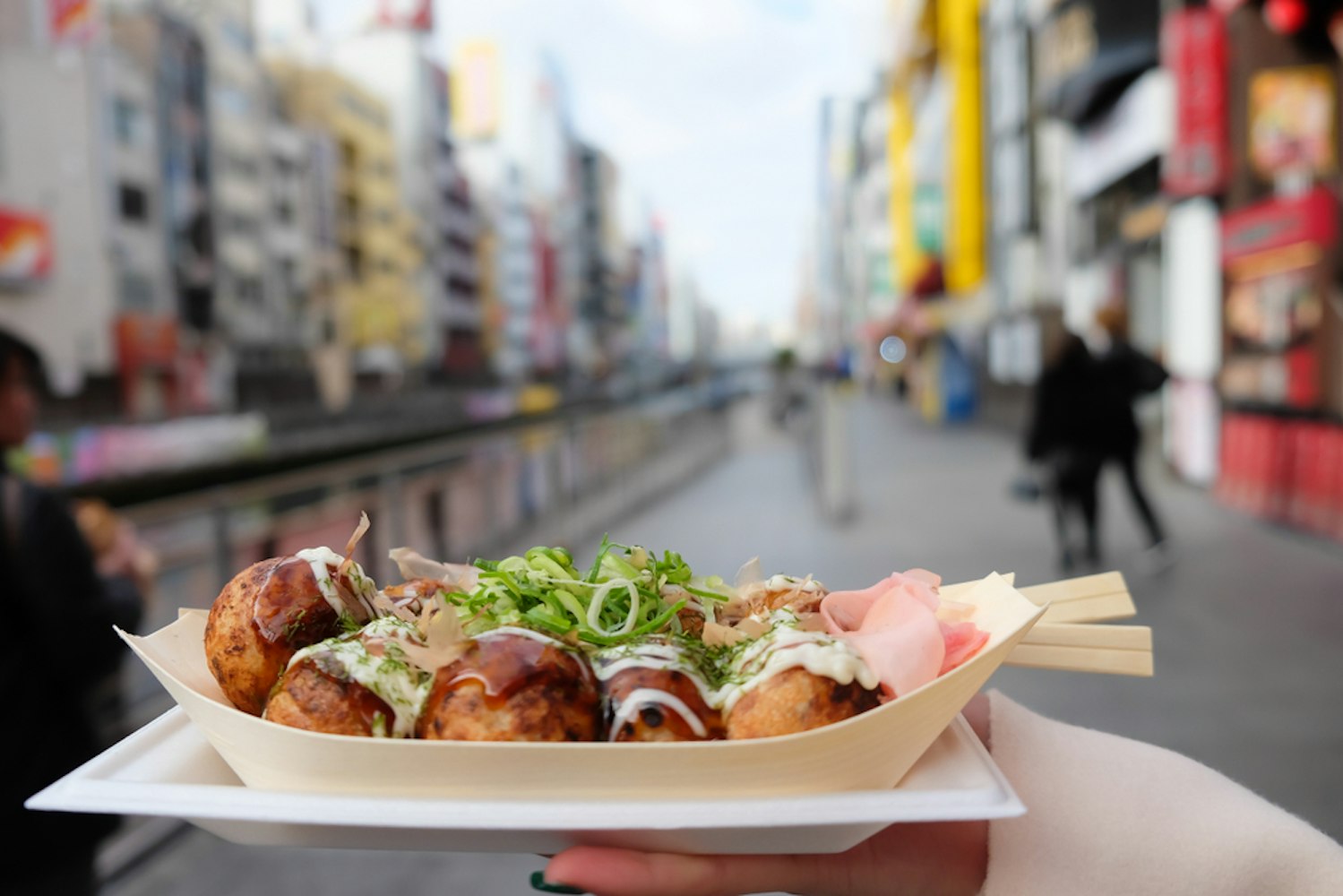
Sweet-toothed visitors should not miss Daifuku Mochi, a soft, chewy rice cake filled with sweet red bean paste. Harajuku's Takeshita Street is famous for its crepes, loaded with everything from fresh fruits and whipped cream to ice cream and cheesecake. For a unique culinary experience, try Menchi Katsu, a crispy, deep-fried ground meat patty, or Unagi Skewer, a skewer of grilled eel known for its sweet, savory, and smoky flavors.
Tokyo, a city with an unparalleled culinary scene, is globally celebrated for its iconic dishes. From sushi and ramen to tempura, the city offers a diverse array of gastronomic delights that are deeply rooted in its culture and history.
Sushi – A Global Phenomenon
Sushi, originally from Southeast Asia, has become an integral part of Tokyo's culinary identity. The city is particularly renowned for Edomae sushi, a style that emerged during the Edo period (1603-1868), where fresh seafood is marinated or boiled before being served on vinegared rice.
When it comes to sushi, Tokyo houses some of the world's most esteemed restaurants. Sukiyabashi Jiro , known from the documentary "Jiro Dreams of Sushi", is one of the city's most prestigious sushi establishments. However, Sushi Saito and Sushi Dai at Toyosu market also offer top-grade sushi, earning high praise from locals and tourists alike.
Ramen – Comfort in a Bowl
Ramen, a comforting noodle dish served in a robust broth, is another staple of Tokyo's food scene. The city presents various types of ramen, including Shoyu (soy sauce) Ramen, Miso Ramen, and Tonkotsu (pork bone) Ramen, each with its unique flavor profile.
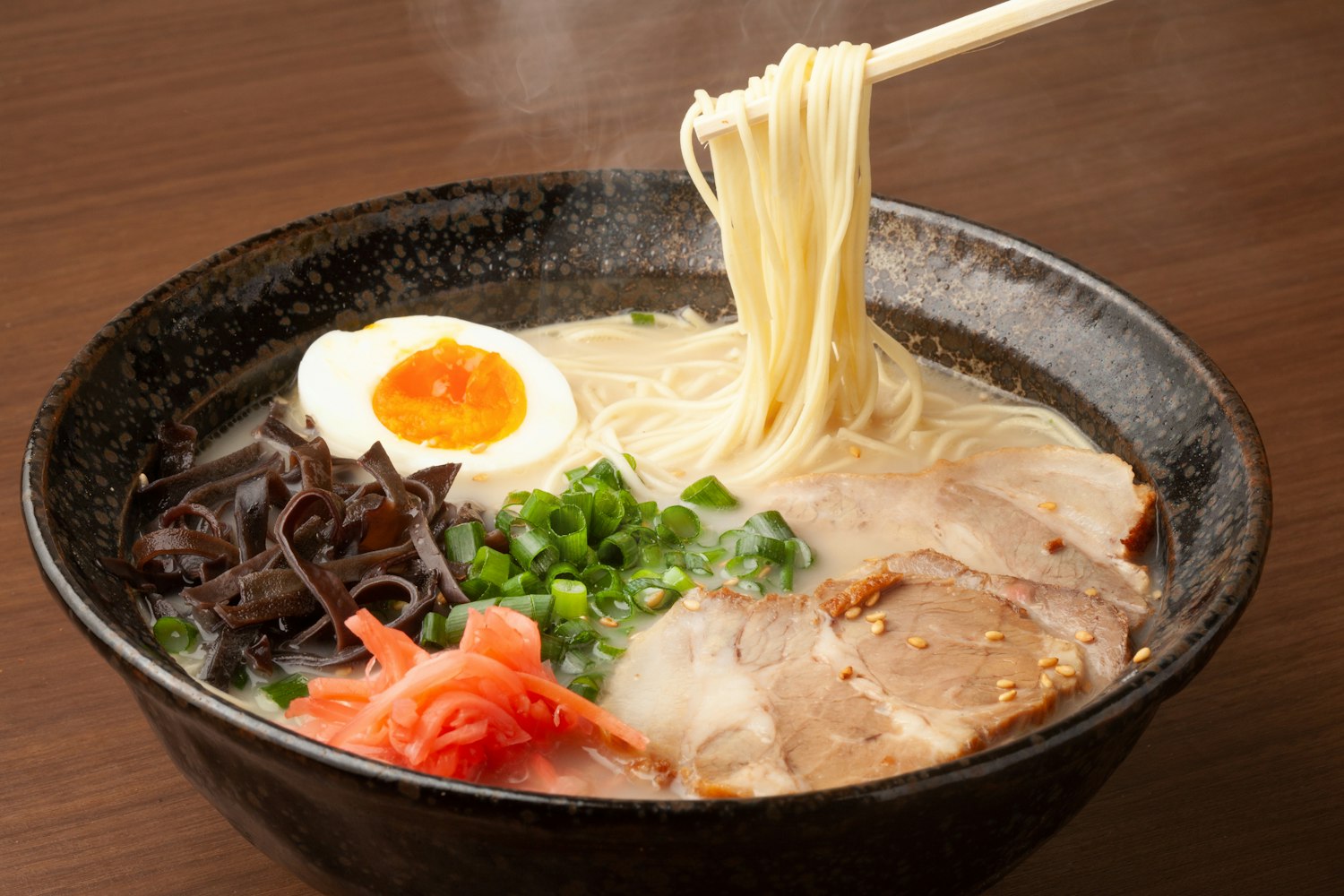
Tokyo hosts numerous acclaimed ramen joints. Tsuta, the world's first Michelin-starred ramen restaurant, is a must-visit. Ichiran, known for its Tonkotsu Ramen, and Fuunji in Shinjuku, famous for its Tsukemen (dipping noodles), are among other popular spots that ramen enthusiasts should not miss.
Tempura – Japan’s Crispy Delight
Tempura, a dish of battered and deep-fried ingredients, originated from Portuguese cuisine in the 16th century and has since become a beloved part of Japanese cuisine. The light and crispy batter, often used with seafood and vegetables, offers a delicate contrast to the tender ingredients inside.
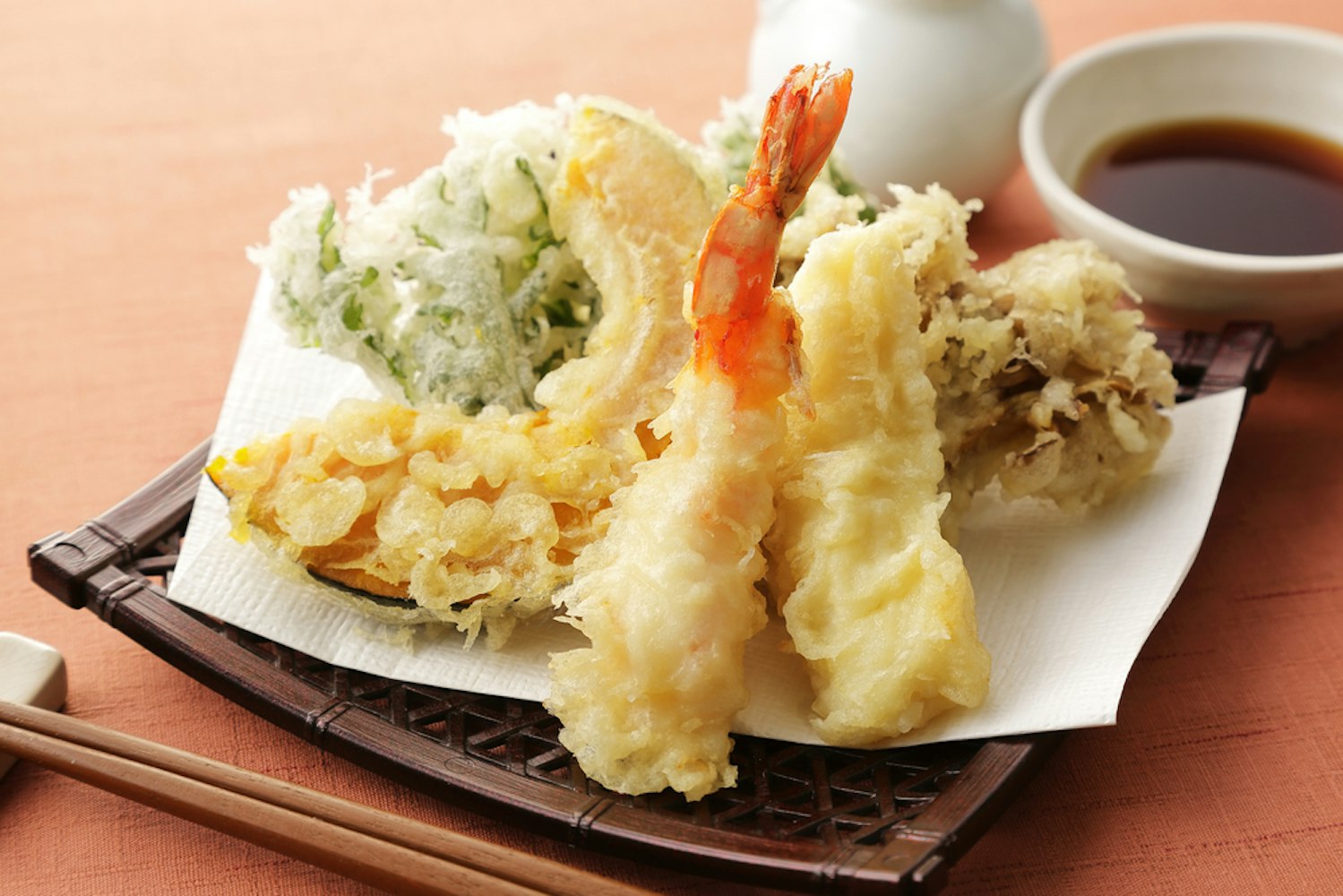
Tokyo offers numerous spots for tempura, ranging from high-end restaurants to casual eateries. Tempura Tsunahachi in Shinjuku, known for its traditional tempura, and Tempura Kondo in Ginza, a Michelin-starred restaurant, are among the top places to enjoy this crispy delight.
Tokyo offers an array of unique dining experiences that reflect its diverse and innovative culinary landscape. From lively Izakayas and conveyor belt sushi restaurants to quirky-themed cafes , the city presents a fusion of traditional and contemporary dining settings that cater to all tastes.
Izakaya – Japanese Pub Culture
Izakayas, often likened to taverns or pubs, are integral to Japan's social dining culture. They offer a casual atmosphere where patrons can enjoy small plates of food, such as yakitori (grilled chicken skewers) and sashimi, alongside a variety of beverages. Izakayas are popular post-work hangouts, providing a unique insight into local life.
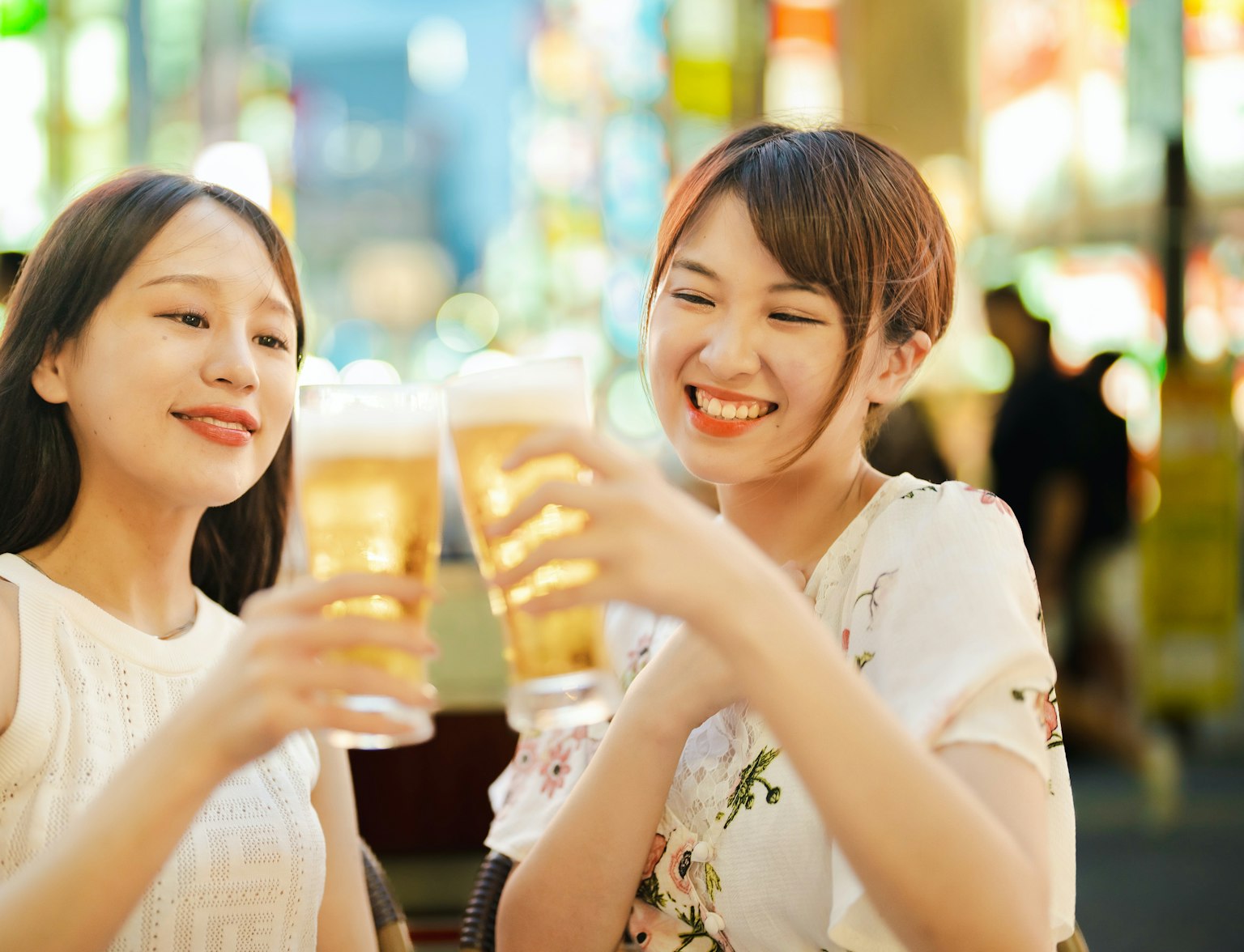
Discover the authentic taste of Japan with our Shinjuku Izakaya tour.
Tokyo is home to countless Izakayas, each with its unique charm. Andy's Shin Hinomoto , close to Yurakucho Station, is a favorite among locals and tourists for its fresh seafood and English-speaking staff. Gonpachi in Nishi-Azabu, often referred to as the "Kill Bill restaurant," is another popular choice due to its traditional Japanese setting.
Conveyor Belt Sushi Restaurants
Conveyor belt sushi restaurants, also known as Kaiten-zushi, provide a fun and convenient dining experience. Here, sushi plates circulate on a conveyor belt, allowing diners to grab their preferred dishes as they pass by. It's a practical way to enjoy a variety of sushi at your own pace.
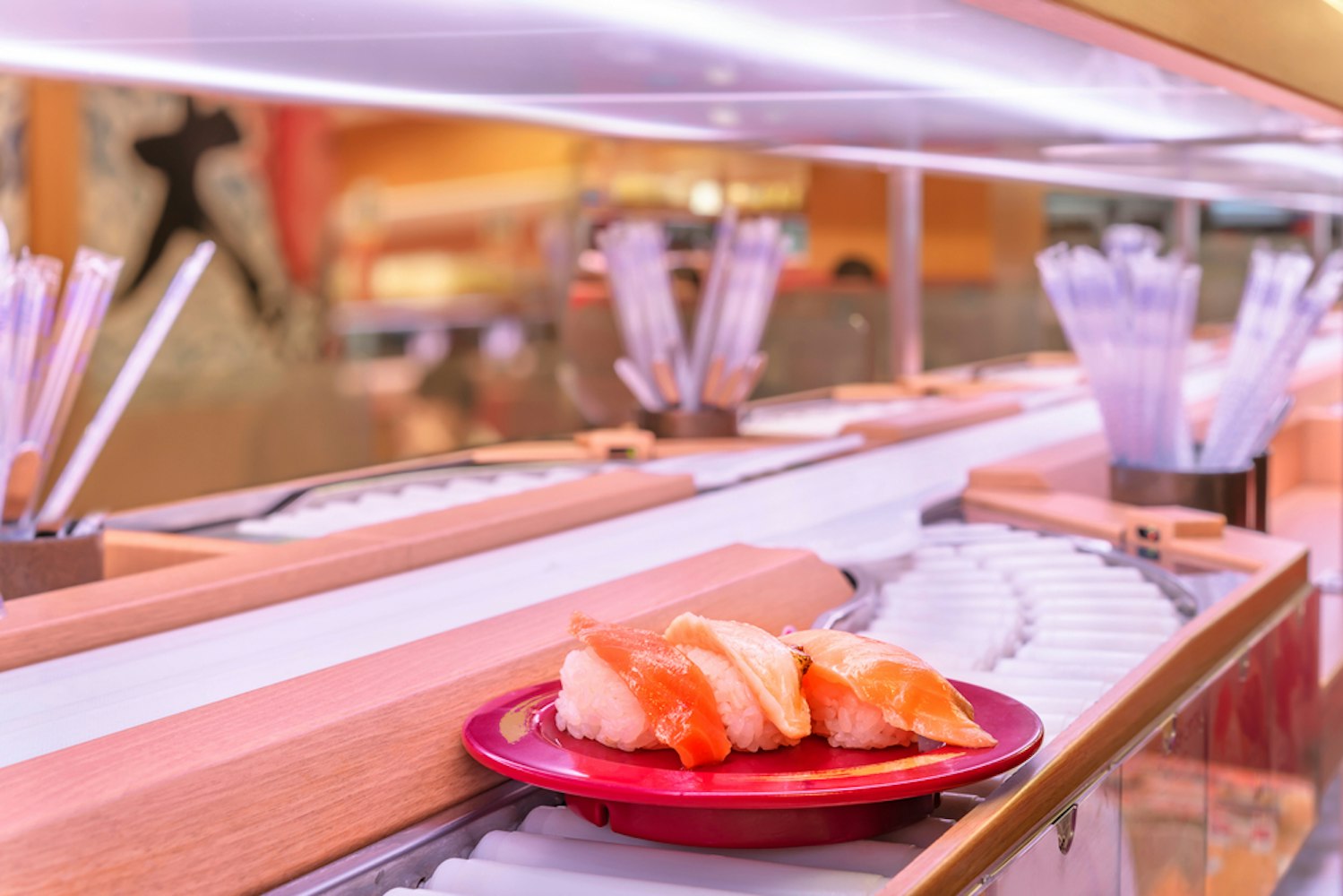
Noteworthy conveyor belt sushi restaurants in Tokyo include Sushiro, one of Japan's largest Kaiten-zushi chains known for its quality and affordability. For a more upscale experience, Uobei Shibuya Dogenzaka offers a wide range of sushi and other Japanese dishes in a modern setting.
Themed Cafes and Restaurants
Tokyo's themed cafes and restaurants offer unique dining experiences that often go beyond food. Animal cafes like hedgehog and owl cafes, maid cafes where staff dress and act as maids, and even prison-themed restaurants are some of the unusual themed establishments you can find in Tokyo.
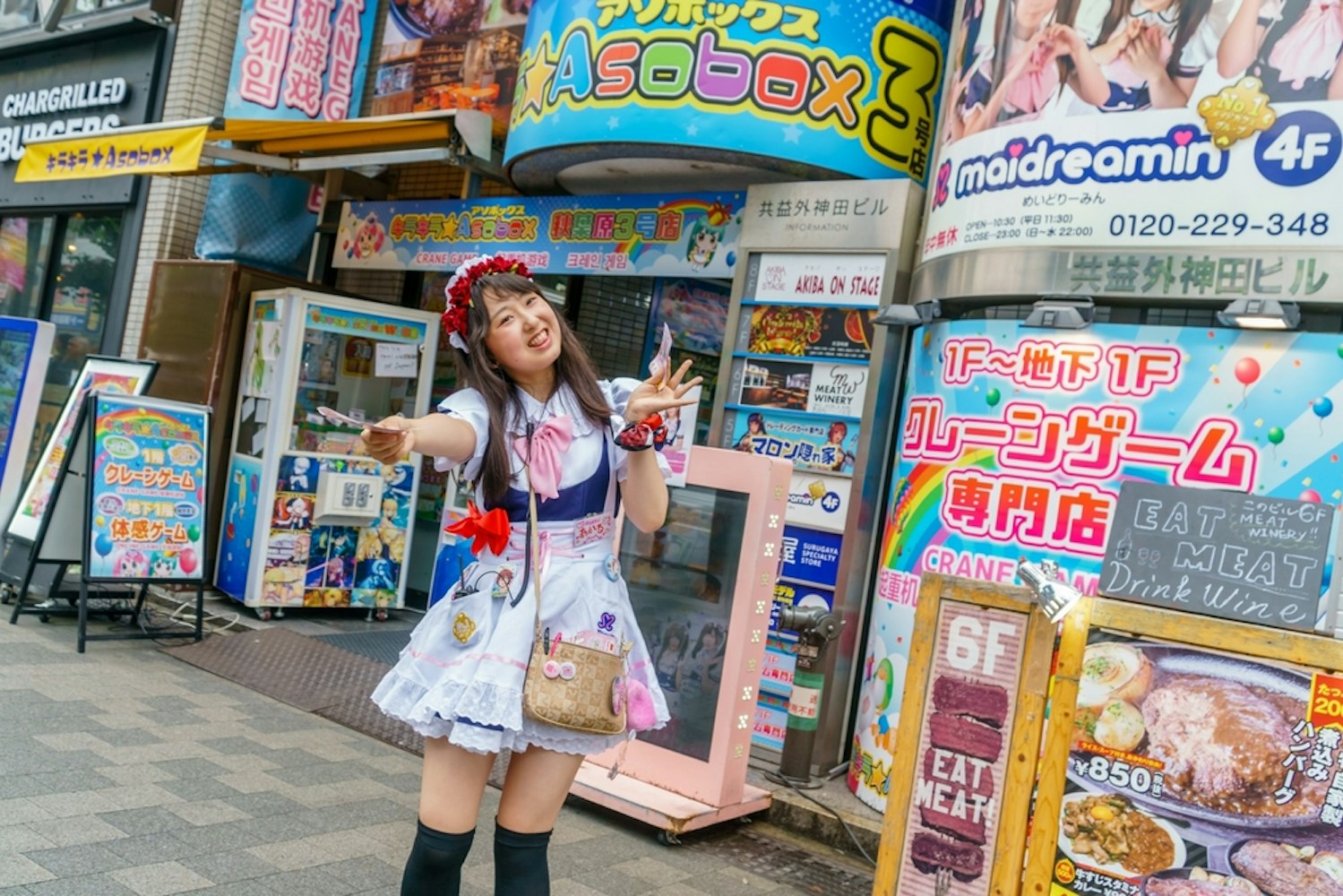
For animal lovers, Hedgehog Cafe HARRY in Harajuku allows customers to interact with hedgehogs while enjoying a drink. Maidreamin in Akihabara , one of Tokyo's most famous maid cafes, offers a unique subculture experience. For something more unconventional, The Lockup in Shibuya serves food and drinks in a simulated prison environment.

Get your entry pass to this cute cafe in Harajuku.
A Culinary Farewell to Tokyo
As we wrap up our food journey through the bustling streets and quiet corners of Tokyo, it's clear that this city is a gastronomic paradise. Every bite we took was an exploration into the heart of Japan's culinary culture, each dish narrating a story of tradition, innovation, and passion.
From the humble street vendors to the sophisticated sushi bars, Tokyo's food scene truly embodies the spirit of 'umami', offering a unique blend of flavors that leaves an indelible mark on your palate.
What food is famous in Tokyo?
Tokyo is renowned for its diverse street food, with options like skewered grilled chicken (yakitori), deep-fried pork cutlet (tonkatsu), and fresh sushi being particularly famous. Exploring the Tokyo street food stalls, especially in areas like Tsukiji Market and Jizo Dori shopping street, is a must for food lovers.
What food is mostly eaten in Japan?
In Japan, rice is a staple, often accompanied by a variety of dishes including miso soup, sushi, sashimi (raw fish), and seaweed. Japanese cooking also frequently features dishes like ramen, udon, and tempura, reflecting the rich and diverse Japanese food culture.
What is Japan's number 1 food?
Sushi, specifically sushi rice paired with raw fish, is often considered Japan's number 1 food. It epitomizes the Japanese precision in cooking and presentation, offering a distinctly Japanese culinary experience that is both traditional and globally popular.
What is the most popular type of restaurant in Japan?
Ramen shops are among the most popular types of restaurants in Japan, offering a casual dining experience. Additionally, izakayas (Japanese pubs) are beloved for their variety of small dishes, perfect for sampling different aspects of Japanese cooking.
How much is dinner in Tokyo?
The cost of dinner in Tokyo can vary widely. Street food items like rice balls or miso soup can be quite affordable, while dining at a fine restaurant, especially for sushi or a hot pot dish, can be more expensive. On average, a meal in Tokyo can range from a few hundred yen for a simple dish to several thousand yen for a fine dining experience.
Continue reading

Osaka Food Safari
After you have had some incredible gourmet dishes – you’ve had the sushi and sashimi, you’ve had the gold flecked ice sorbet, you’ve had the blowfish and lived… it’s time to get down into Osaka town for some soul food. Osaka is much unlike Tokyo-the urban megacity and Kyoto-the refined historic cultural center. Osaka is an industrial town with regular people living the lives of the “everyman and everywoman” of Japan. As such, the style and culture and FOOD reflect that side of the people. Let’s take a deep dive into Japanese soul food. Come with our guides on an Osaka Food Safari and try local dishes, drink their sake and beer, maybe do some cooking along the way. We take you to the center of the city where many small eateries and street vendors line the road. We’ll be grazing our way through Japanese food and enjoying every noisy step of the way. There will be no zen reflection here as the people of Osaka are fond of saying, “Eat until you drop”. Let’s put that challenge to the test!

- Cast & crew
- Episode aired Dec 5, 2007

Maeve O'Meara joins legendary restaurateur Tetsuya Wakuda who gives tips on the key ingredients in Japanese cuisine. Maeve O'Meara joins legendary restaurateur Tetsuya Wakuda who gives tips on the key ingredients in Japanese cuisine. Maeve O'Meara joins legendary restaurateur Tetsuya Wakuda who gives tips on the key ingredients in Japanese cuisine.
- Maeve O'Meara
- Tetsuya Wakuda
- Kimitaka Azuma
Top cast 14

- Self - Host
- (as Masahiko 'Mark' Tojo)
- All cast & crew
- Production, box office & more at IMDbPro
User reviews
- December 5, 2007 (Australia)
- Kismet Productions
- See more company credits at IMDbPro
Technical specs
- Runtime 25 minutes
Related news
Contribute to this page.
- IMDb Answers: Help fill gaps in our data
- Learn more about contributing
More to explore
Recently viewed.
Food Safari
Information
© 2008 Special Broadcasting Service Corporation
Copyright © 2024 Apple Inc. All Rights Reserved.
Internet Service Terms Apple TV & Privacy Cookie Policy Support


- Rent or buy
- Categories Categories
- Getting Started

Food Safari
- Episode number
- Newest episodes
- Available to watch

Customers also watched

How are ratings calculated? Toggle Expand Toggle Expand
- Amazon Newsletter
- About Amazon
- Accessibility
- Sustainability
- Press Center
- Investor Relations
- Amazon Devices
- Amazon Science
- Sell on Amazon
- Sell apps on Amazon
- Supply to Amazon
- Protect & Build Your Brand
- Become an Affiliate
- Become a Delivery Driver
- Start a Package Delivery Business
- Advertise Your Products
- Self-Publish with Us
- Become an Amazon Hub Partner
- › See More Ways to Make Money
- Amazon Visa
- Amazon Store Card
- Amazon Secured Card
- Amazon Business Card
- Shop with Points
- Credit Card Marketplace
- Reload Your Balance
- Amazon Currency Converter
- Your Account
- Your Orders
- Shipping Rates & Policies
- Amazon Prime
- Returns & Replacements
- Manage Your Content and Devices
- Recalls and Product Safety Alerts
- Registry & Gift List
- Conditions of Use
- Privacy Notice
- Consumer Health Data Privacy Disclosure
- Your Ads Privacy Choices

- Search Search

Okinawa Food Safari: Essential dishes everyone should try
As a frequent diner at my local Japanese restaurant, I thought I had a pretty good grasp of the country’s cuisine. But, when I had the chance to visit Japan’s southernmost prefecture, the stunning islands of Okinawa , I soon realised I’d barely scratched the surface.
A prefecture of Japan since the 19th century, Okinawa was historically part of the Ryukyu Kingdom, with its culture a mix of Japanese, Chinese, and Korean. As a result, its culinary scene has taken liberal inspiration from all of these to create something wholly unique.
If you’re looking for a destination with rich history, culture and delicious cuisine to boot, look no further than magical Okinawa.
Here are some of its must-try dishes.
Before we can jump into the food, we need to first mention awamori – a distilled version of sake unique to Okinawa. Why? Because it’s so strongly linked to the local cuisine.
Made from long grain rice, awamori is similar in flavour to whisky and regularly enjoyed on the rocks or in cocktails. You’ll also spot it on the table at most restaurants in the form of a spicy condiment infused with chilli too.
Awamori is a great icebreaking tipple, one that opens doors and starts conversations with those around you.
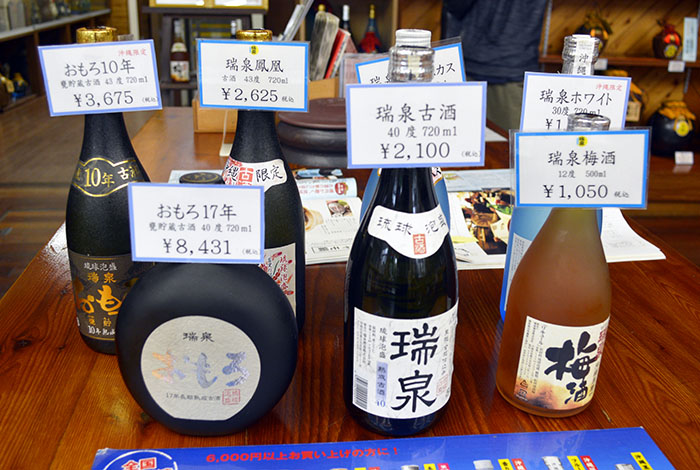
Distinctly Okinawan, Soki Soba is a delicious noodle soup, which usually features thick wheat noodles, fish cake and a generous slice of pork belly or boneless pork ribs.
The meat is boiled to remove excess fat, then stewed in a mixture of awamori, soy sauce and sugar for several hours. It’s a hearty dish guaranteed to warm you up on a cold day.
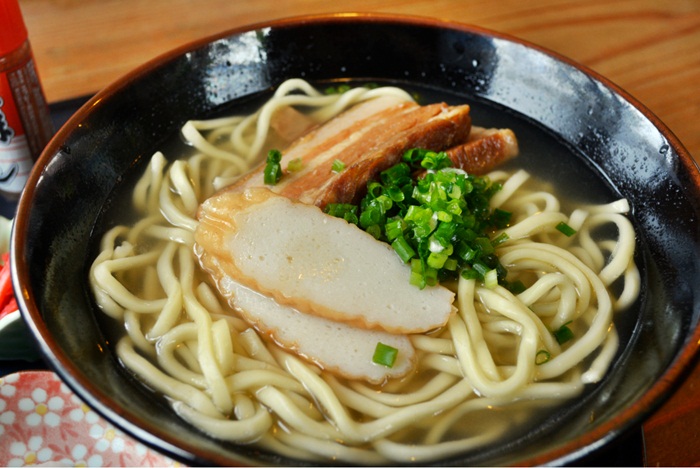
Goya Champuru
Goya is a hard thing to explain to the uninitiated. Often referred to as a bitter melon, it looks a bit like a shrivelled cucumber… yet its bitter flavour and texture are vastly different.
The most common way to eat goya is in a stir-fry or soup, although it’s also available as dried crisps and even as a soft drink. Goya champuru (which means ‘ something mixed ’ in Okinawa) is a stir-fried dish featuring thinly sliced goya, tofu, egg and pork.
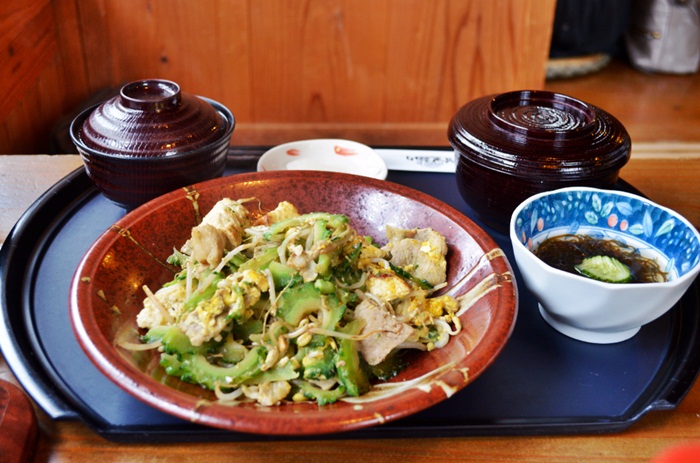
Commonly served as a side dish or snack, mimiga is thinly sliced cartilage from a pig’s ear, which has been boiled or steamed then mixed with various flavourings. It has a slightly crunchy texture. Although it may sound a bit scary, it’s surprisingly delicious – and is great served with beer!
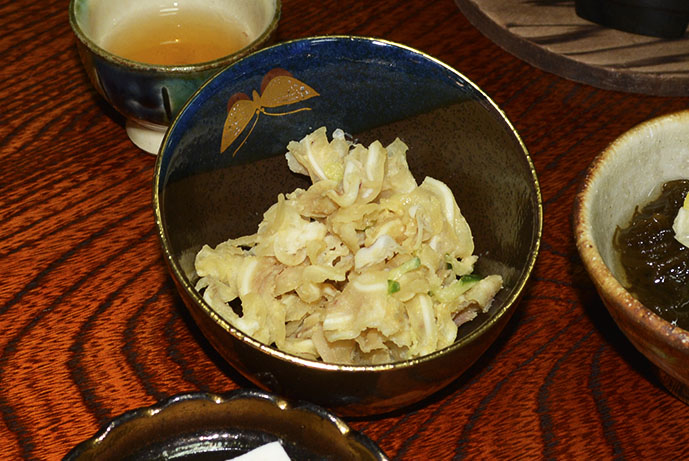
Sata Andagi
Sata andagi is a sweetc deep-friend bun made from flour, sugar and eggs. Golden brown on the outside, soft and fluffy on the inside, the texture is similar to that of a doughnut. Native to Okinawa, sata andagi is prepared using a mix of Japanese and Chinese techniques.
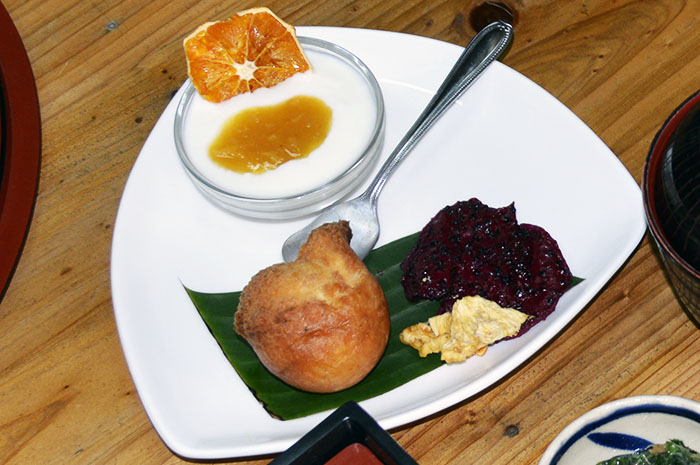
Mozuku Su doesn’t look pretty, but it tastes amazing… and judging by how often it was served to me during my week in Okinawa, chances are you’ll probably come across it too.
This soft and slimy seaweed is high in minerals and low in calories. It’s commonly cooked in a marinade of vinegar and pickle vinegar, and served with a garnish of ginger or cucumber.
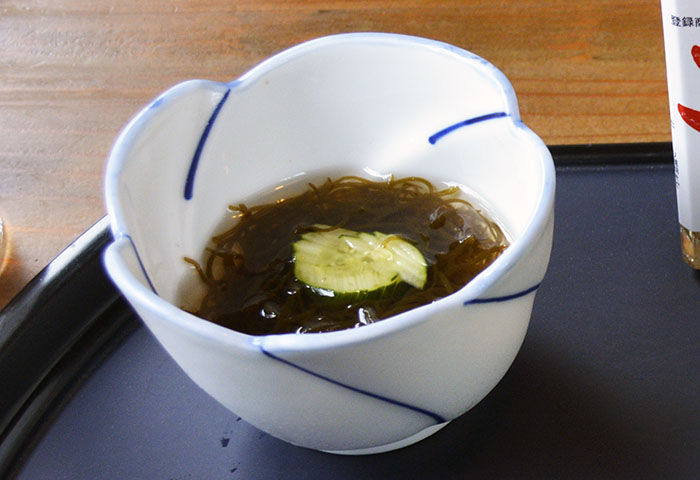
Longevity Meal at Emi no Mise
For the adventurous, a visit to ‘Emi no Mise’ in Ogimi Village is an absolute must. Like a crash course in Okinawan cuisine, their Longevity Meal features 14 mouth-watering dishes such as homemade golden noodles with skiikwasaa, purple sweet potato dumpling, bamboo shoots in soy broth, tempura with shrimp and fennel, and champuru (stir-fry) made with green papaya.
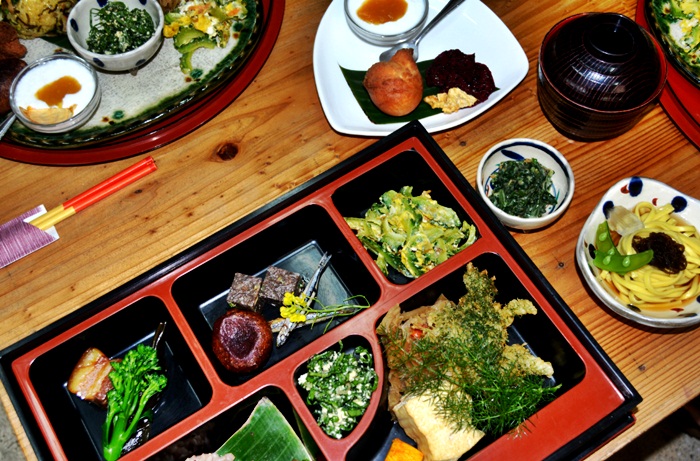
If there’s one bit of advice I can give anyone thinking of going to Okinawa, or the rest of Japan for that matter , it’s to be adventurous. There are so many wonderful dishes that are very, very different to what we have here in Australia, so the best thing you can do is go with an open mind and be willing to try whatever is served.
Chris Ashton
We're Chris Ashton and Simon Ceglinski, two Aussie travellers with a love of exploration and adventure, and the odd bit of luxury thrown in. We seek out street art, street food, and scuba diving wherever we go, and prefer the road less travelled over well-worn tourist paths.
Related articles

Feels Botanical: The Australian Eau De Vie spirit that suits your mood
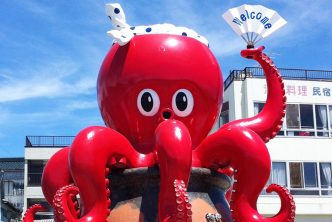
Why Aichi should be on your Japan travel hitlist

Tahiti and New Caledonia: 10 romantic things to do

Bali’s Hottest New Bars and Restaurants
19 comments.
Sata andagi is where it’s at. So wonderful, and there are a few places in our area (Seattle) that serve it or something similar.
I haven’t seen it for sale anywhere in Oz. Might need to look up the recipe if I’m going to get my next sata andagi fix.
Nice tour de force of Japanese cuising, loved the post 🙂
Thanks Voyager – I’m heading over to mainland Japan next month so there will no doubt be a follow up post to this one.
I LOVE Japanese food and I am surely I’d truly enjoy this! Unfortunately Okinawa wasn’t part of my itinerary, when there, but I am hoping to go back and there is no doubt that this time, I will inlcude it!
Interesting cuisine! That GOYA CHAMPURU ingredient seems to be ‘bitter gourd’ (in India also, we have it as dried crisps)!
Yeah, they had dried crisps in Okinawa too – I ate waaay too many.
While I do like me some bento boxes, this is one cuisine I feel quite sure I can skip in life. Loved your post and photos though.
Thanks very much 🙂
This looks like fun! I think I would like the Soki Soba the best. They all look pretty good though.
I’ll take the whiskey and the donut, please. 😉
Haven’t been and think I must, just to eat! How long did you visit?
I was there for around four or five days, it was a short trip but managed to pack quite a bit in to it. I’d suggest a week would be plenty.
Mmmm! I don’t have much experience with Japanese food outside of the basics, so I learned a lot from this list. Great, mouthwatering photos…That longevity meal is calling my name!
Thanks to this post, I now know a few names in Japanese Cuisine 🙂
Well, what can I say…this looks all so great!! Japanese food is so nice, and it’s difficult to find a great japanese restaurant, so going to Japan would be the best option, I guess 🙂
A food safari sounds like my kind of safari! I love sushi and most Japanese cuisine that I’ve tried so far, but the foods you shared in this post would have been new to me, as well. It all looks incredible though. Trying new and local foods is all part of the adventure, right?
I love Japanese cuisine. The Soki Soba looks great. We were surprised how much of their food is pickled or preserved (especially all the accompaniments.) Although when you think about it more, it is understandable.
Thanks for the fantastic food safari!Honestly,I wasn’t familiar with Japanese cuisine, apart from Sushi ofcourse.But, thanks to you, now I know more!

Recent Posts
- A closer look at Kyoto’s Kinkaku-ji Golden Pavilion
- Los Angeles’ most beautiful runs
- What it’s like visiting the Korean Demilitarized Zone (DMZ)
- Photos: Mepaica Festival on Nusa Lembongan
- Treetop Luxury: the best jungle resorts in Southeast Asia
- Stanley, Tasmania really turns on the charm in the ‘off season’
Popular Categories
- Food & Wine
- Arts & Culture
- Travel Advice

Destination
- Sao Tome & Principe
- South Africa
- New Zealand
- French Polynesia
- United Kingdom

Australasia & South Pacific

Latin America

Middle East
- Wayfairer Experience
- Responsible Travel
- Eco by Wayfairer
- Eco Gold by Wayfairer
- Beach Holidays
- Conservation Focused Holidays
- Family Beach Holidays
- Family Holidays with Babies
- Family Holidays
- Family Safari Holidays
- Luxury Holidays
- Safari and Beach Holidays
- Safari Holidays
- Trekking Holidays
- Travel Inspiration Travel Inspiration
- Get in touch +44 117 313 3300 [email protected]
Japan Food Guide: Learning About Japanese Cuisine

Slurp soba, sip sake, munch mochi and gorge on the freshest sushi in the world.
The best way to get to know a country and understand its culture is through its food, and Japan has no limits when it comes to gourmet flair.
So, we’ve put together this ultimate Japan food guide full of hands-on foodie experiences and opportunities to learn more about Japanese cuisine during your visit to the Land of the Rising Sun.
Here are 19 foodie experiences every curious culinary connoisseur should try and squeeze into their next Japan trip:
- 1. Sushi at the fish market
- 2. Kaiseki at a ryokan
- 3. Afternoon tea with a geisha
- 4. Hot spring boiled eggs
- 5. Osaka street food safari
- 6. Japanese whisky in Tokyo
- 7. Sake-tasting contest
- 8. Kobe beef
- 9. Cooking class
- 10. Cute themed cafes
- 11. Making soba noodles
- 12. Traditional tempura
- 13. Bento box lunch
- 14. Vegetarian food with monks
- 15. Cooking an omelette at your table
- 16. Visit a wasabi plantation
- 17. Hairy crab in Hokkaido
- 18. Vending machine ramen
- 19. Hanami picnic
1. Sample Sushi at Tokyo's Fish Market

No Japan food guide would be complete without a mention of sushi, which can be found in restaurants and carousels around the whole of Japan. However, we believe that the ultimate sushi experience can be found in Tokyo 's lively fish market.
As of October 2018, Tokyo’s historic Tsukiji Fish Market is sadly closed, but its successor Toyosu is set to open soon . Most visitors opt to get to the market early to watch stall sellers shouting prices and showing off their fresh seafood to local chefs looking for the best product. Others arrive even earlier, at the crack of dawn, to see the tuna auction.
After some exploring of the market (bring waterproof shoes), opt for a late sushi breakfast at one of the many restaurants around and in the market. These get busy quickly though, so make sure you get there early, book ahead if possible, or take a ticket and come back later.
2. Feast on a Kaiseki Banquet at a Traditional Ryokan

Kaiseki is a special meal of many small courses, often taken during a stay at a traditional Japanese ryokan (guesthouse). The dishes are usually seasonal, the ingredients fresh and sourced locally, and the meal is lovingly prepared in an exquisitely plated display. The multi-course set-up is also a great opportunity to try many different kinds of Japanese cuisine.
You may not recognise the dishes on offer (or indeed, many of the ingredients), so it may be an idea to ask ahead for a written version of the menu, so you can learn about what you’re eating. If you have any dietary requirements, make sure that you let the ryokan know well in advance as they buy ingredients according to the number of guests.
For more information about what to expect in a kaiseki banquet, including the order and contents of each course (with fun cartoon references), read Gurunavi’s Guide to Kaiseki .
3. Have Afternoon Tea with a Geisha in Kyoto

Geisha are often misunderstood in the West, but these professional artists, entertainers and caretakers of traditional Japanese culture are fascinating to learn about.
An invitation to an ochaya (teahouse), where geisha entertain, is a rare opportunity even for local Japanese, as social hierarchy and connections dictate whether you are a suitable candidate.
However, as part of our Japan Honeymoon tour we offer the chance to have afternoon tea with a geiko (geisha) or maiko (apprentice geisha) at a local ochaya in Kyoto . As part of this experience, you can enjoy green tea, Japanese confectionaries and a traditional dance performance by a geisha.
After the performance, you can take photos and ask any questions you may have, with the help of a translator. It’s a real opportunity for an exclusive look into the mysterious world of geisha.

4. Try Eggs Boiled in the Volcanic Waters of Japan’s Hot Springs
Eating eggs boiled in the volcanic hot springs of an onsen town is a must if you’re heading off the beaten path to rural Japan . Onsen tamago (hot spring eggs) are poached by the geothermal waters and served in a soy dashi broth.
The eggs are lowered into the hot springs and gently poached for up to 40 minutes, giving the eggs a silky, custard-like consistency. You’ll often see them served with breakfast, or on top of rice or noodle bowls during lunch and dinner.
5. Participate in a Street Food Safari in Osaka

Osaka is Japan’s culinary capital and the canal district of Dotonbori is where you can find the best local delicacies. With flashing neon signs of competing restaurants and steaming smells of street food, you’re sure to find something that takes your fancy.
One of the best ways to explore what Dotonbori has to offer is via a “street food safari” tour of the district with a local food guide, which diverts off the tourist track to the backstreet izayaka (pub-restaurants) frequented by Osakans. Sample takoyaki octopus dumplings and kushikatsu fried skewers, as well as other Osakan dishes.
6. Swig Japanese Whisky at a Hotel Bar in Tokyo

You may be more familiar with a peaty Scotch or an American bourbon, but Japanese whisky (yes, spelt without the e) is rising in popularity across the globe. Japanese whisky has been brewed for over a century, using the help of Scottish methodology to open the first distillery in Yamazaki in the early 20th Century.
The drink resembles a gentle scotch, with a silky-smooth taste and makes good use of the soft mineral water found in the natural springs of Japan. You can learn more about the best Japanese whisky in a recent GQ article on the history, production and rise in popularity of the beverage.
Have a Lost in Translation moment and sample a Japanese whisky at your hotel bar (or the Park Hyatt Tokyo, where Lost in Translation was filmed). You may be pleasantly surprised.
7. Take Part in a Sake-Tasting Contest in Takayama

Although Japanese whisky is rising up the ranks, Japan’s traditional beverage of choice is still sake. This clear rice wine has a high alcohol content but a sweet taste and can be served hot or cold – often in a small porcelain bottle, which is decanted into a matching porcelain cup.
One of the best places to sample sake is in Takayama , a small city in the Japanese Alps famous for sake production and home to many micro-breweries.
Our Food & Art: Cultural Tour of Japan includes a sake-tasting session in Takayama, where you can try different sakes, discuss similarities and differences, as well as how to pair sake with food. Make sure you’re paying attention though, as the session ends with a blind sake tasting contest and the winner receives a prize!
8. Splash Out on Exquisite Kobe Beef

Kobe beef is a luxurious (and expensive) Japanese delicacy famous for its tenderness, flavour and signature fatty, marbled texture. One of the best places to try Kobe beef is, of course, the city of Kobe. If you're unsure, check a restaurant's certification first to make sure you’re really trying authentic Kobe beef.
Kobe beef is a variety of Wagyu and the cattle is raised to such strict standards (none of which include getting massages, drinking beer or listening to classical music – those are all myths), only around 3,000 head of cattle qualify as true Kobe beef each year. It's easy to see why Kobe beef is the absolute height of Japanese cuisine.
So, contrary to what you may have seen advertised in restaurants in the West, real Kobe beef is very rarely available outside of Japan, so don’t miss the opportunity to try this indulgent dish while you have the chance.
For more information about what makes Kobe beef authentic, read this article on Wagyu and Kobe beef on the Steak University website .
9. Take a Cooking Class

of the best ways to understand a culture is through its food, so a cooking class is a great way to discover more about Japanese cuisine and customs. Plus, you can even take a piece of Japan home with you, replicating the dishes for friends and family.
As part of our Highlights of Japan tour , we include a cooking class in Kanazawa , where you can learn to make maki sushi, Japanese-style omelette and jibuni, a local dish. This three-hour cooking experience takes place in a traditional machiya townhouse and is conducted in English.
(This cooking course can also be customised for dietary requirements upon request.)
10. Visit a Cute Themed Café
Japan loves anything kawaii (cute), so there are plenty of themed cafes to choose from, especially in Tokyo. From controversial maid cafes to cartoon-character fare to animal cafes to robot waiters, your experience is sure to be bizarre and unique!
Popular character-themed cafes include those with décor and dishes featuring Hello Kitty, Doraemon (a blue robot-cat) and Gudetama (an apathetic egg), among many others. A visit to one of these cafes is a great thing to do if you’re travelling Japan with kids .
You can find animal cafes with cats, owls, hedgehogs, goats… you name an animal and it probably exists in a café in Tokyo somewhere. However, be aware the animals at these establishments aren’t meant to live in such conditions, with many treated poorly.
Therefore, even thought we've included a mention in this Japan food guide, we would advise you not to patronise these cafes with your tourist dollars and instead, opt for another themed café (there are plenty to choose from).
For more ideas on weird and wonderful themed cafes to visit, read Klook’s guide to the 10 most bizarre cafes in Tokyo (we highly recommend an evening at the Robot Restaurant!).
11. Make Your Own Soba Noodles in Matsumoto

Buckwheat soba noodles can be eaten either hot or cold in a variety of dishes. Originating from the Japanese Alps, one of the best places to sample soba is in the alpine town of Matsumoto .
The Takagi soba shop in this town boasts an impressive 130-year history and offers soba-making classes for those who wish to learn more about the process of making noodles. The class takes approximately one hour and is conducted mostly in Japanese, though it's easy enough to follow.
12. Nibble on Tempura at a Century-old Restaurant in Kyoto
Tempura is another quintessential Japanese dish you must try while you’re in Japan. It consists of seafood or vegetables that have been lightly battered and deep fried, though it isn’t as heavy or greasy as you may think.
If you’re visiting Kyoto on your Japan trip, one of the best tempura restaurants can be found at Tempura Yasaka Endo, a tempura institution with an impressive century-long history, set in an old ochaya (teahouse). A branch can also be found at the Celestine Kyoto Gion Hotel.
13. Buy a Bento Box for Lunch or Make Your Own

A bento box is a lunchbox taken to the next level, often divided into several sections and featuring little portions of food, which combine to make a whole meal. Bento can be found throughout Japan in convenience stores, bento shops, train stations… anywhere where you might eat lunch on the go.
You may also see kyaraben (character bento), which is an elaborate arrangement specially decorated around a theme, cartoon or video game. This is another must for a family holiday to Japan .
You could even make your own bento lunchbox at a bento-making class in Kyoto, where a small food school runs sessions with instruction in English. You’ll create five or six seasonal dishes (including teriyaki chicken, tempura, sushi and miso), then eat your creation in time for lunch.
14. Eat Humble Vegetarian Fare with Local Monks at Mount Koya
Buddhist monks eat a simple diet of vegetarian fare (shojin-ryori) and the best place to try this type of food is at a Buddhist monastery. Mount Koya , in the Kansai region, is home to a huge monastery complex and you can even stay overnight in the temple lodgings there.
Breakfast and dinner are included in your stay, however you’ll be dining with the monks, so the timings are set according their the daily routine. Morning sutra reciting starts at 7am and breakfast is served afterwards at 8am, whereas dinner is taken at 5pm in the communal shukubo building.
15. Cook an Omelette at Your Table in Hiroshima

The name okonomiyaki literally translates as “what you like, grilled,” referring to the variety of ingredients you can choose to put in your dish. Sometimes referred to as Japanese pizza, this savoury cabbage pancake is typical of the Kansai and Hiroshima regions of Japan, but you’ll see it throughout the country as well.
First, decide which ingredients you’d like to include, then cook the pancake on a hot plate at your table – what you like, grilled! Typical fillings include meat, seafood, vegetables and cheese – often topped with a thick, sweet sauce, Japanese mayonnaise, pickled ginger and seaweed and bonito flakes.
16. Visit a Wasabi Plantation in the Japanese Alps
Near Matusmoto, the aforementioned home of soba noodles, is where you can find Daio Wasabi Farm, the largest wasabi plantation in Japan. The fresh alpine water provides the fields of wasabi with a special irrigation system that makes wasabi cultivation possible.
The farm also makes for a great visit for tourists who wish to learn more about the fiery green paste they see next to their sushi rolls. Walking trails around the farm and the idyllic rural setting with old-fashioned, wooden water wheels are very pleasant.
On your way out, make sure you pop into the farm shop and restaurant to ogle at the range of wasabi products on offer. Aside from the obvious wasabi paste, snacks and flavoured noodles (which make for great souvenirs), why not try wasabi beer, wasabi chocolate or wasabi ice cream?
17. Hairy Crab in Hokkaido

If you’re travelling to Japan in the winter, you will get to taste one of the delicious species of Japanese crabs on offer, especially in the northernmost island of Hokkaido.
The hairy crab gets its name from the spiky hairs on its body and is slightly smaller than the snow crab and red king crab. Due to its size, the hairy crab can be more difficult to eat, but the sweet flavour makes the effort worth it. The crab is boiled in saltwater, cut into sections and eaten by hand.
The snow crab has a bumpy shell and long, skinny legs. The males are larger than the females, so they can be more expensive due to the larger amount of meat on them. The females contain orange egg sacks, which are also tasty and often served over rice or on sushi.
The red king crab is a monster with a shell around 25 centimetres wide and a leg span of over a metre. Despite its vast size, the meat is light and you’ll have no problem handling the large portion.
You may also see a hanasaki (blooming flower) crab , noted for its bright red colour. It’s smaller than the red king, though their appearances can be similar. The meat is sweet and the females’ eggs are particularly delicious.
18. Order Ramen from a Vending Machine

Ramen soup noodles are beloved all over the world, but eating ramen in Japan is a completely different experience, not just because of the wider variety of flavours on offer, but because of how you can order this famous dish – via vending machine!
Placing your food order through a vending machine is common practice in Japan, especially for ramen shops. Insert cash, press your chosen dish and add any sides, then you’ll be granted a ticket. The efficient system leaves little room for error and a speedy service (as long as you know what you want to order first).
19. Take Part in a Hanami Picnic
Visiting Japan during spring means ample opportunity for cherry blossom (sakura) viewing, which is a popular pastime for the Japanese during the change in the seasons. Hanami (cherry blossom viewing) involves a picnic party under the cherry blossom trees with friends and family.
Grab a picnic blanket, a bottle of wine and a hanami-themed bento (you’ll see a lot of cherry-blossom-flavoured food and drink options available around Japan during the spring) and spend your day eating, drinking and laughing under the picturesque trees of fluffy pink, weather pending.
The Ultimate Japan Food Guide: What to Eat Where
Japanese cuisine is rich in both taste and tradition, with a huge range of different dishes and flavours to choose from (be sure to tell your family and friends back home its not all sushi!). We've only just started to scrape the surface of Japanese food with our Japan Food Guide, recommending experiences to have as well as delicacies to try.
We hope this ultimate Japan Food Guide has helped inspire you to get hands-on with your meals on your next holiday to Japan, given you some context about some of Japan's most famous dishes and made you just a little bit hungry.
Wayfairer Travel provides tailor made luxury tour itineraries with a focus on responsible, sustainable and ethical travel. To discuss your next trip to Japan, don't hesitate to contact our friendly team of luxury travel specialists to discuss a bespoke Japan travel itinerary suited to your specific needs and interests.
We understand that booking trips, especially adventurous and alternative ones such as this can be intimidating, so get in touch; we can take the stress out of your holiday planning and organise a trip you won’t forget!
More inspiration from wayfairer customers and travel specialist.
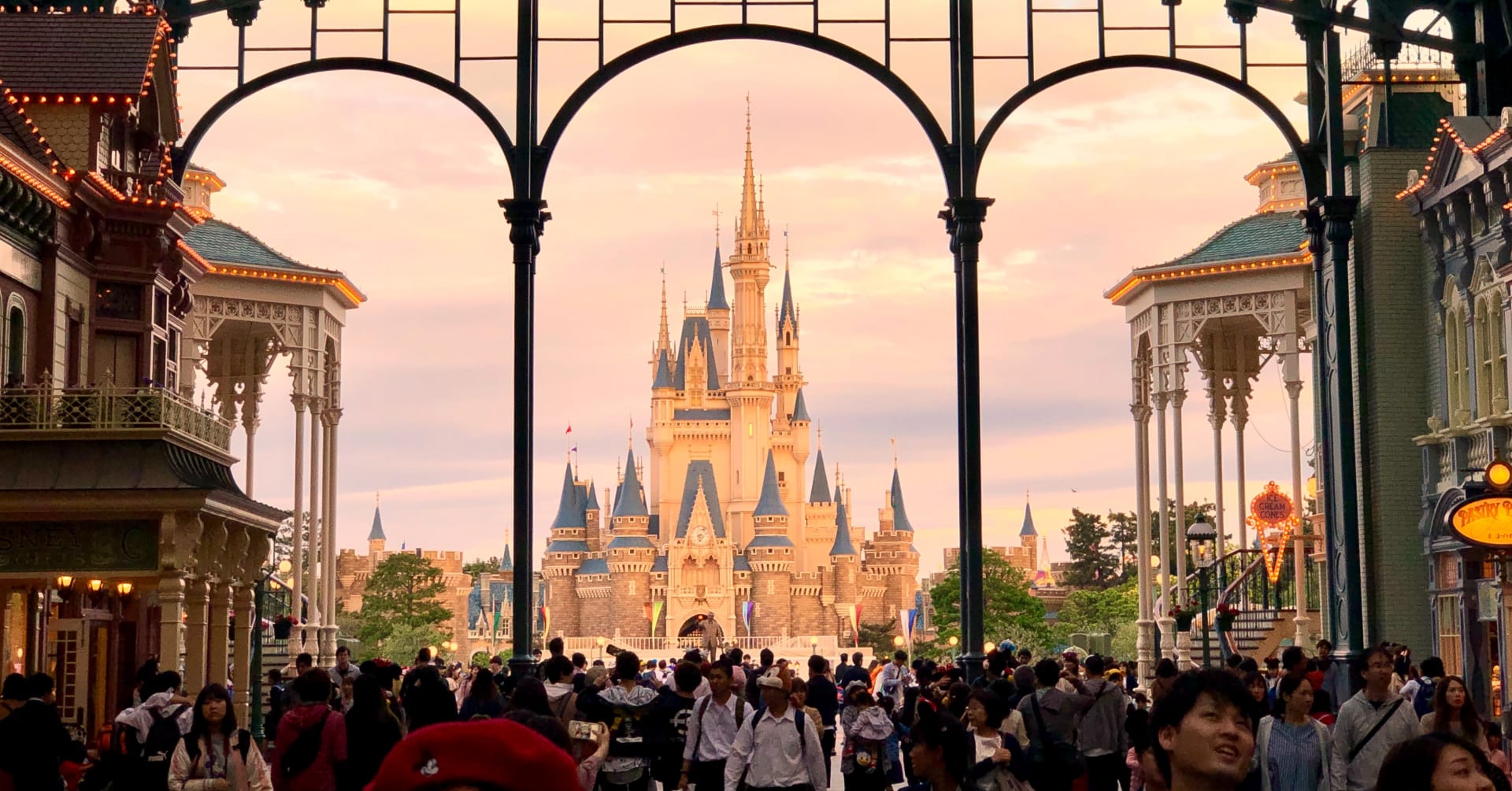
Best Places to Visit in Japan for Families
December, 11, 2023

7 Best Places to Visit in November 2023
November, 5, 2023
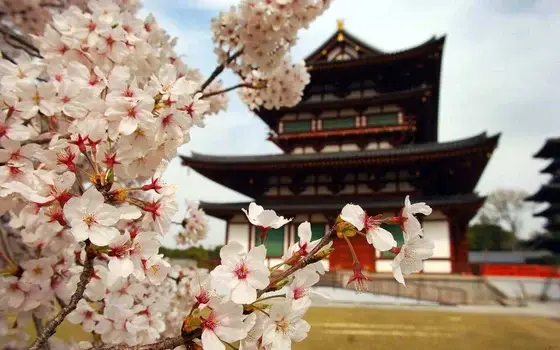
How to Enjoy Cherry Blossom Viewing in Japan
April, 14, 2023

Sign up to our newsletter
For more travel inspiration delivered straight to your inbox just fill in your details here
Food Safari | Episode guide
Food safari takes you on a culinary journey across australia. producer-presenter maeve o'meara has spent most of her life seeking out great food, recipes and the clever people who make simple ingredients sing. her access-all-areas camaraderie with everyone from three-hat chefs to passionate home-cooks results in a series that feeds food enthusiasts’ desire for insider knowledge..

Source: Food Safari
Have a story or comment? Contact Us
Share this with family and friends
Articles from The Cook Up with Adam Liaw

Slice recipes your granny will want to steal

Swift suppers: Speedy new favourites ready in under 20 mins

Six-ingredient pasta nights

11 recipes for every lover of sweet & sour

Find your own 'perfect': The Invy Baker's advice on bread making

The ever-evolving art of Japanese soufflé pancake
Japanese Food

The best things Lisa Curry has eaten at the Olympics
Olympic Games

This 'cake within a cake' is Natalie Paull's go-to baking showstopper
Sbs food newsletter, get your weekly serving. what to cook, the latest food news, exclusive giveaways - straight to your inbox..
By subscribing, you agree to SBS’s terms of service and privacy policy including receiving email updates from SBS.
Bring the world to your kitchen
Fuji Safari Park
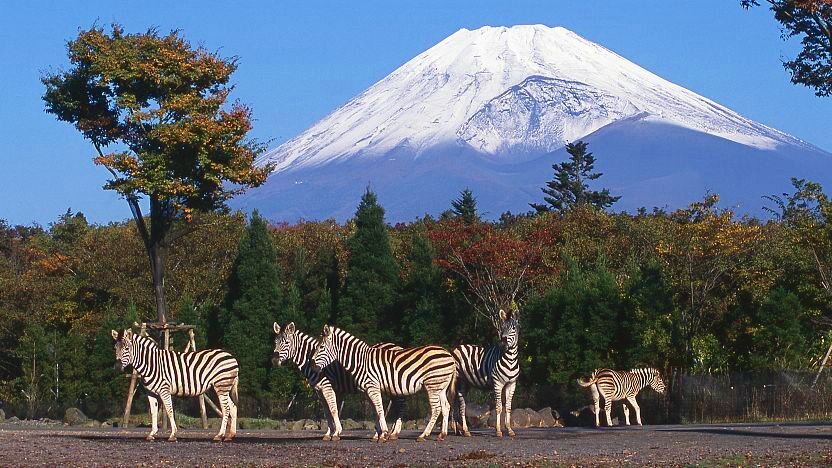
The Fuji Safari Park (�x�m�T�t�@���p�[�N) is a wildlife park on the southern slopes of Mount Fuji where visitors can take a safari through the simulated habitats of freely roaming animals, including lions, tigers, bears, giraffes, cheetahs, elephants, rhinoceroses, zebras and bison. It is one of the largest and most popular safari parks in Japan.
There are multiple ways to explore the park's safari zone: by your own car, by a rental car, by bus or on foot. No additional fee is charged if you drive through the safari zone with your own car . On average, it takes visitors about an hour to complete the course, but the road through the park is broad enough to allow each car to proceed at its personally preferred pace.
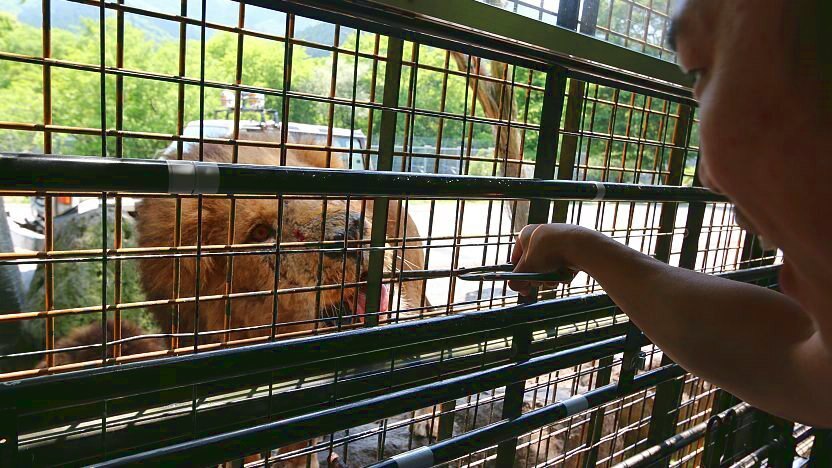
Bus tours take about an hour and employ large, caged buses designed to look like the different animals found around the park. During the tour, participants are allowed to feed bears, lions and camels with pieces of vegetables, fruits and meat through the caged windows of the bus. The tours cost an additional 1500 yen per person including food and may sell out on busy days.
Available for rent at the park are 4WD vehicles painted in a striped zebra pattern and equipped with a navigation system to lead you on a self guided tour through the safari zone. The rental fee is 6500 yen, and the vehicles seat up to seven passengers. Along the way you can feed the park's large herbivores, such as camels and gazelles, through the vehicle's caged windows. A valid driving license recognized by Japan is required for renting these vehicles.
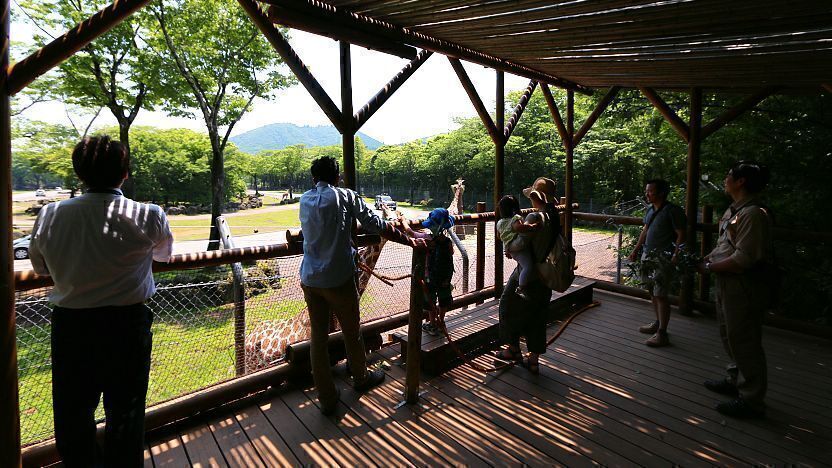
Another great way to explore the park is on foot along a 2.5 kilometer nature trail that leads around the safari zone. The trail is open from late March to November and takes about two hours to complete including stops at the various observation decks and blinds along the way where you can look out at the animals in their habitats.
At some of the points along the trail you can purchase food, such as leaves, pellets and raw chicken to feed to the animals. The walking safari costs an additional 600 yen per person and is only for visitors aged four and above. The price for food varies from 100 to 500 yen.
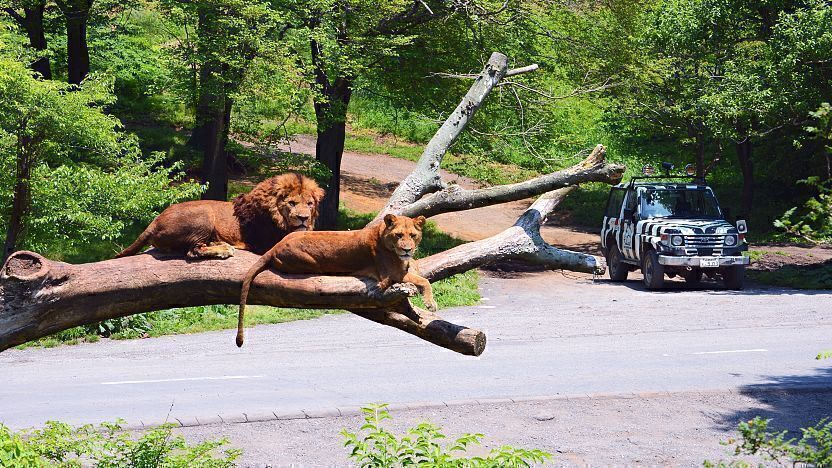
Besides the Safari Zone, the Fuji Safari Park also maintains a regular zoo zone where visitors can see a variety of animals such as red pandas, meerkats, leopards, hippopotamuses and ring-tailed lemurs. It is possible to feed several of the animals (at a small additional cost) or enter their cages, including kangaroos, capybara and squirrel monkeys.
Paid activities include horse cart rides, pony rides and pictures taking with baby animals (if available). There are also cat, dog and rabbit houses and a guinea pig area where visitors can spend time holding and playing with the different animals. The activities vary in price, but typically cost around 500 yen. The safari park also offers multiple restaurants and a well stocked souvenir shop.
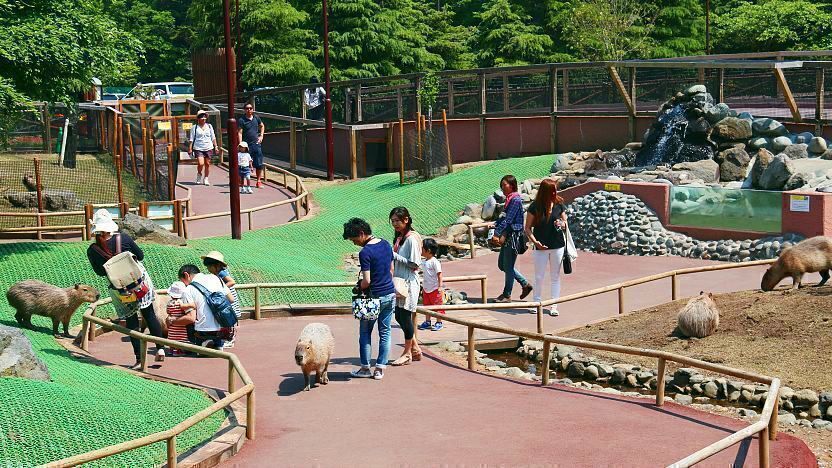
Getting there and around
The Fuji Safari Park is located on the southern slopes of Mount Fuji and is connected to nearby train stations by bus . The most frequent route connects the park to/from Gotemba Station every two hours (35 minutes, 780 yen one way). Buses to/from Mishima and Fuji stations are less frequent.
Alternatively, a rental car is recommended to simplify access and use of the safari park. Rental outlets are available around most major railway stations in the area, including Mishima and Gotemba stations.
Hours and Fees
Questions? Ask in our forum .
Links and Resources

14 Popular Breakfast Foods In Japan You Should Know
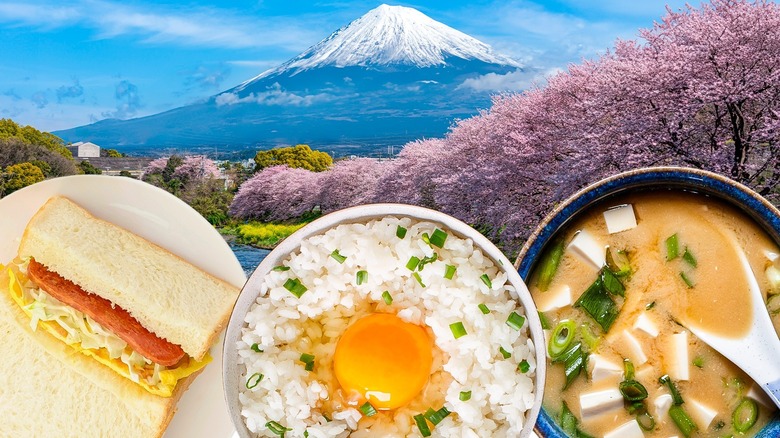
Breakfast staples can vary considerably from country to country. In the Western world, eggs are the star, with bacon, potatoes, syrupy pancakes and waffles, hot and cold cereal, and other filling staples. Breakfast in Japan , however, includes many foods also enjoyed for lunch and dinner. It is centered around a balanced selection of nutrients essential to a well-rounded day.
Philosophy is inherent to everyday life in Japan, even when it comes to breakfast. "Ichiju sansai" is the basic framework that informs how food is served in traditional Japanese cuisine, which is known as "washoku." The philosophy refers to meals composed of one soup-type dish, one main dish, and two sides. "Ichi" translates to one, "ju" to soup, "san" is three, and "sai" means dishes — "one soup, three dishes."
It's also a more nutritious way to start your day. Whether breakfast, lunch, or dinner, ichiju sansai provides carbohydrates for energy, pickled foods for improved digestion, protein-rich meats and seafood, and veggies for vitamins, minerals, and fiber. Because of this approach, traditional Japanese breakfast is largely indistinguishable from lunch and dinner. It's evolved over the years, though, and today incorporates Western staples, too. To explore Japan's unique take on morning meals, we have fervent home chef Yuka Allen to help us. Born and raised in Japan, she has first-hand experience with popular Japanese breakfast foods you should know.
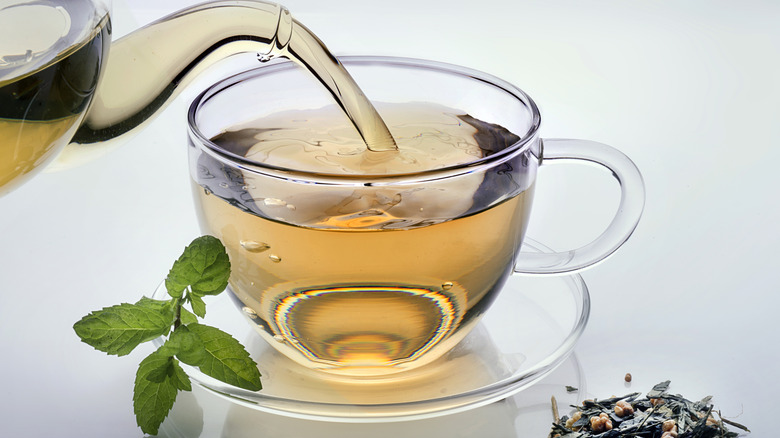
Coffee is America's favorite morning booster, but in Japan, green tea kicks off the day. There are several varieties of Japanese green tea . Matcha, sencha, and genmaicha are a few popular types. Tea, or "cha," is traditionally served in a teacup (or yunomi), which is set atop a saucer or small tray and held with both hands when enjoyed. Locals consume this ancient beverage throughout the day for its life-supporting benefits. According to Statista , it's the number-one tea variety in the country.
Green tea has been used to improve mental alertness, alleviate digestive issues and headaches, and promote weight loss for thousands of years. Along with the aforementioned types, other popular varieties include gyokuro and hojicha. Each varies in how they are cultivated, which impacts taste, aroma, and caffeine content. All Japanese green teas contain some level of caffeine, which is great for sluggish mornings. That said, many locals drink coffee for breakfast as well. It's still considered a Western tradition but is widely available at kissatens (Japanese tea-drinking shops), ryokans (Japanese inns), convenience stores, and even in vending machines.
Steamed rice (gohan)
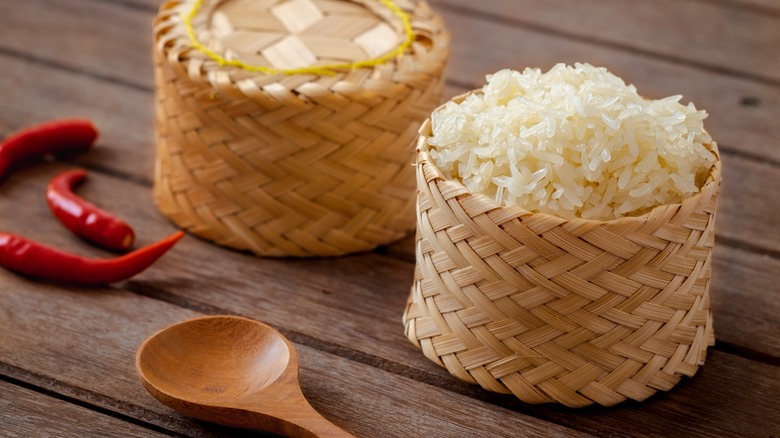
You might be surprised to learn that steamed rice, known as "gohan," is an essential Japanese breakfast staple. Locals eat rice around the clock, and Japan is known to produce 300 variations of the grain. When it comes to sticky rice, the Koshihikari variety is the most popular. It has a subtle sweetness, starchy texture, and shiny appearance, and is not the same thing as sushi rice . Other common sticky rice types include Akitakomachi, Nanatsuboshi, Hitomebore, and Hinohikari; each has distinct characteristics. Akitakomachi is light and easily digestible and the one many say is the best for breakfast.
"Both of my children now prefer gohan for breakfast, instead of toast. I usually don't eat breakfast now but I like gohan when I'm on trips staying at breakfast-serving hotels or inns with natto, nori, yakizakana and misoshiru," Yuka Allen says. Rice provides carbs like toast and potatoes do in the West. It's typically served plain and paired with other dishes. Locals like to spruce it up with flavorful furikake, which is a combination of nori seaweed, shiso herb, and roasted sesame seeds — though other blends exist as well.
Miso soup (misoshiru)
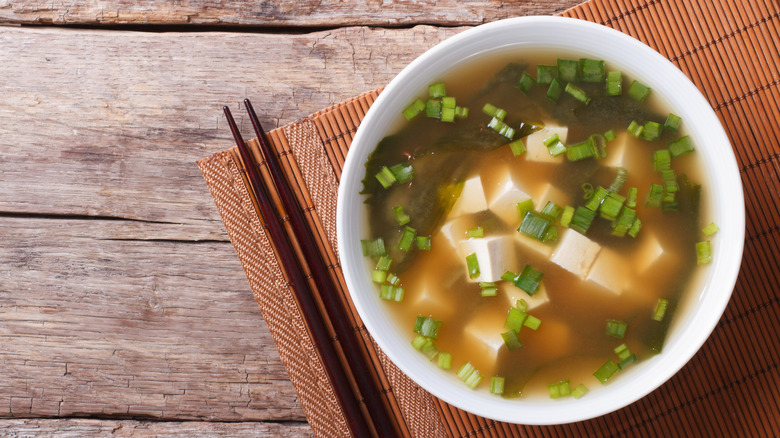
Misoshiru is one of the most widely consumed soups in Japan. Umami-rich and sea-infused, it's a traditional soup enjoyed from sunup to sundown. The taste comes from a fermented paste made of steamed soybeans, salt, water, and Koji, a fungus cultivated for culinary use and the country's "national fungus." While mostly associated with sushi restaurants in America, in Japan, miso soup is a simple recipe for breakfast too. "Misoshiru is usually paired with gohan in my house. I make mine with two or three different veggies and tofu because that's how my mother always makes them more nutritious," Yuka Allen added. Along with being one of the country's ubiquitous flavors, it offers a range of vitamins and minerals like manganese, copper, zinc, iron, calcium, and more.
Thousands of miso paste varieties exist, but there are three main categories: white, red, and yellow. Red is fermented longest and packs the most robust flavor, yellow follows, and then white is the mildest. They can be made from either rice, barley, soy, or a blend of the three. Japan has many regional styles of miso soup. Some are made with salmon and potatoes and others with crab and ginger. Misoshiru is not only the most common, but it's the one most often eaten for breakfast.
Pickled veggies (tsukemono)
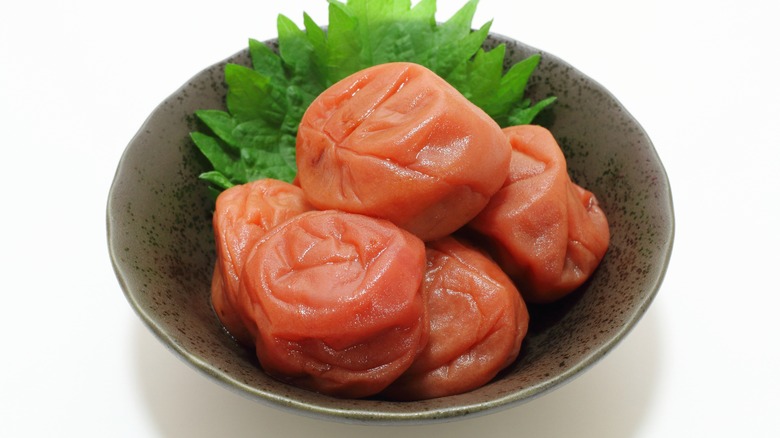
Pickling and fermentation have been practiced in Japan for centuries. Adding a refreshing zest, pickled foods are delicious and nutritious, and come in many varieties and styles. Napa cabbage, ginger, Daikon radish, umeboshi (plum), and eggplant are popular types. They vary in flavor, texture, and presentation, and pair perfectly with gohan (steamed rice). "Tsukemono" is an umbrella term for pickled and fermented foods in Japan, under which there are several sub-categories. "Oshinko" refers to lightly pickled vegetables infused with salt or vinegar brine. They are the pickled vegetables you should add to your breakfast plate.
"Nukazuke" is another common vegetable pickling style. Unlike Oshinko, it uses roasted rice bran (or nuka), in place of salt and vinegar. The process can take anywhere from a few hours to several months. "I now make nukazuke, a kind of tsukemono, at home, trying to increase fermented food intake for health reasons," Yuka Allen shares. Pickled and fermented foods are loaded with antioxidants, great for morning digestion, and an excellent source of vitamins and minerals – another reason to try traditional Japanese breakfast.
Fermented soybeans (natto)
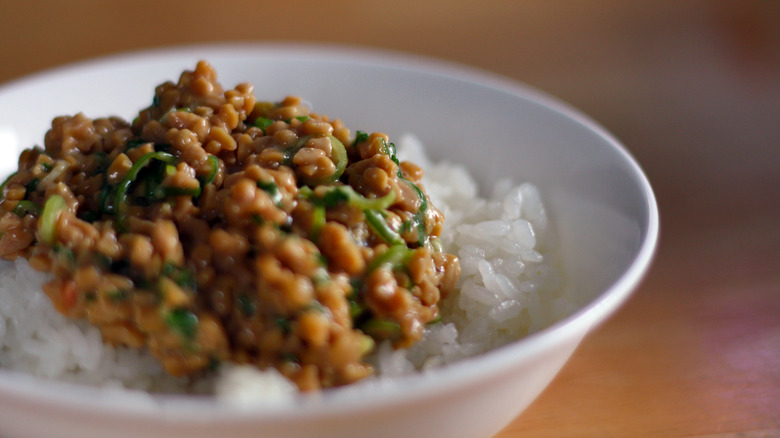
One Japanese breakfast food that you'll either love or hate is "natto." It's even an acquired taste for locals. Don't let the cute name fool you, natto is a fermented soybean dish known to pack a pungent punch. It has a savory, nutty profile and looks like baked beans covered in a sticky substance that stretches like cheese. The texture may take first-timers some getting used to, but the flavor is remarkably mild when paired with rice. Yuka Allen adds, "I grew up in the northern part of Japan where natto is commonly consumed, and my father always served natto for weekend breakfast with tons of chopped fresh green onion and katsuobushi (bonito flakes)."
A versatile ingredient that's protein-rich with probiotic benefits, natto is an essential Japanese breakfast food for good reason. Probiotics, in particular, are known to improve gut health. It's primarily blended with rice but can also be topped with ingredients like soy sauce, green onions, poached eggs, pickles, and others. Dashi seasoning is another tasty topper. It's made with dried seafood broth and karashi (Japanese mustard). Pre-made store-bought natto usually contains a packet of dashi. Natto is a versatile ingredient that can add flare to many of your favorites.
Roasted seaweed (several names)
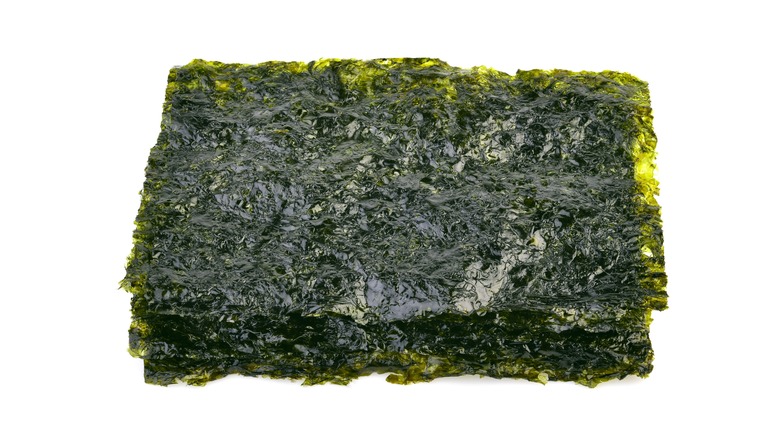
As an island surrounded by abundant ocean life, it's no surprise that seaweed is a common ingredient in Japanese cuisine. It's intensely salty with an unmistakably aquatic flavor that's surprisingly versatile. Popular foods like sushi, rice balls, miso soup, and ramen only scratch the ocean's surface. A deep dive reveals that locals enjoy seaweed for breakfast too. Fun fact: Seaweed is an umbrella term for over a hundred edible varieties. Nori, kombu, hijiki, and wakame are the most widely consumed in Japan.
It's traditionally eaten with gohan (steamed rice) for breakfast. "Dipping an edge of nori in soy sauce and wrapping it around hot gohan is unassumingly simple but makes a great flavorful breakfast," Yuka Allen adds. You can also wrap toasted nori sheets around Japanese breakfast staples like rolled eggs (tamagoyaki) and grilled fish (yakizakana). You can't go wrong with an energizing bowl of breakfast ramen (asa ramen) either. Or you can keep it simple with a filling rice ball (onigiri). Seaweed not only imparts fishy flavor into dishes, but it is also a great source of iodine, supports thyroid function, and may improve your gut and heart health.
Grilled fish (yakizakana)
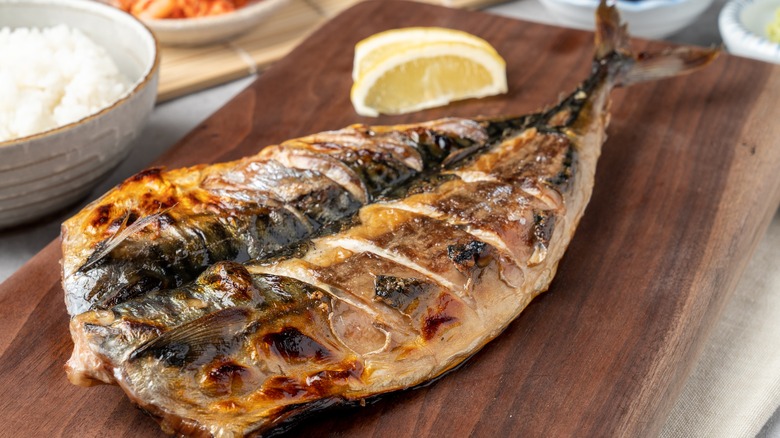
A well-rounded Japanese breakfast wouldn't be complete without yakizakana, or grilled fish. It's protein-rich like natto, and, surprisingly, it is consumed in the country more than raw fish. Fish types like salmon (sake), mackerel (saba), sardines (iwashi), whitebait (shirasu), and mackerel pike (sanma) are morning favorites. They were traditionally grilled over charcoal, but cooking in a pan or broiling in an oven is just as common nowadays. "Although I don't cook them for breakfast at home, I love a piece of saba or sake shioyaki with white rice while I'm traveling," Yuka Allen says.
Japan's grilling style is all about simplicity , and that goes for the seasoning, too. Japanese cooks and chefs traditionally use only salt, or pairings like soy sauce with wine vinegar, soy sauce and mirin, or miso and sugar. The savory flavor of grilled fish goes great with tangy pickled vegetables, too. It's definitely a Japanese breakfast dish you need to try at least once.
Rolled eggs (tamagoyaki)
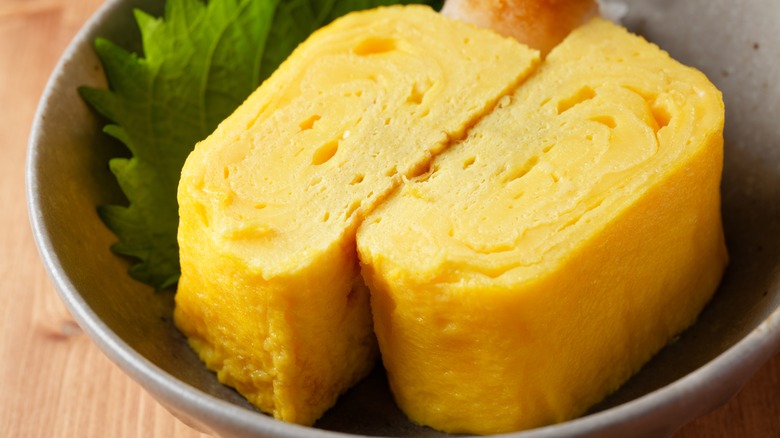
Eggs play a prominent role in Japan's food scene, but for breakfast, " tamagoyaki " is the style that most prefer. Fluffy and tender, the beloved dish is made with beaten eggs fried and then rolled into thin sheets. It's usually seasoned with a simple blend, but there are many ways to add flavor — from fish stock and sugar to soy sauce, or customized with ingredients like American omelets. There are no limits to what ingredients complement this egg-tastic treat. Grated radishes with soy sauce are common, along with green onion, seaweed, and eel. You can also mix tamagoyaki into rice or put it on a sandwich.
Whether sweet, savory, herbaceous, or with pickles, tamagoyaki is one of the best parts of the Japanese breakfast experience. This must-try custardy sweet tamagoyaki recipe is unlike any egg dish you'll find in America. Or you can simply put a Westernized spin on it with cheese and bacon. As you can imagine, ketchup tastes awesome on tamagoyaki, easily one of the best egg dishes from Japan .
Egg and rice bowl (tamago kake gohan)
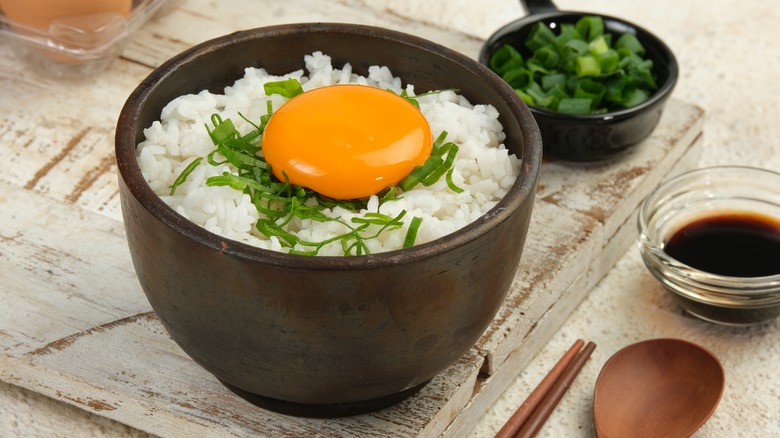
Another popular egg dish is " tamago kake gohan ," or egg on rice. It's not only a breakfast favorite but one of Japan's most famous comfort foods. A raw egg is cracked into a steaming bowl of hot rice and then drizzled with soy sauce. When stirred together, the pairing is a tasty way to fill up on protein and carbs. Piping hot rice partially cooks the raw egg, giving the dish a creamy consistency like risotto.
"[Tamago kake gohan is] another childhood weekend staple breakfast in my upbringing, and my kids seem to love it too. I know eating raw eggs is unthinkable for many Americans," Yuka Allen adds. Aside from soy sauce, tamari, MSG, and furikake are also flavoring favorites. It's a dish with few limitations, though, so it goes with crumbled roasted nori, sesame seeds, diced green onions, pickled ginger, and more.
Submerged in tea rice (ochazuke)
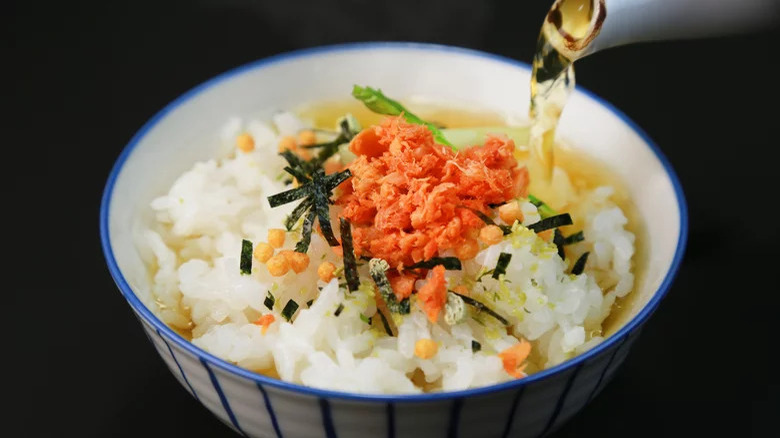
Tamago kake gohan is not the only Japanese dish that is considered a breakfast and comfort food classic, ochazuke is another. It means "submerged in tea" rice, and is literally that, though nowadays it is also made with dashi. Leftover rice inspired people to develop the idea centuries ago. They discovered that soothing tea-over-rice was the perfect dish. Tea and rice were affordable and accessible ingredients, so ochazuke naturally grew in popularity. The leftover rice is steeped in steaming green tea, which gives it a creamier consistency and imparts toasted earthiness. Savory ingredients like grilled fish, nori, and roe are frequent flavor additions.
Tea can also aid digestion. "My mother likes to pour hot tea in a small amount of rice in a bowl she can't finish otherwise. She likes to put in salty sakekawa or umeboshi," Yuka Allen recalls. Dashi-flavored ochazuke follows the same steps but is for those who prefer a seaweed-infused kick. It's especially satisfying in the morning after a night on the town.
Rice porridge (okayu)
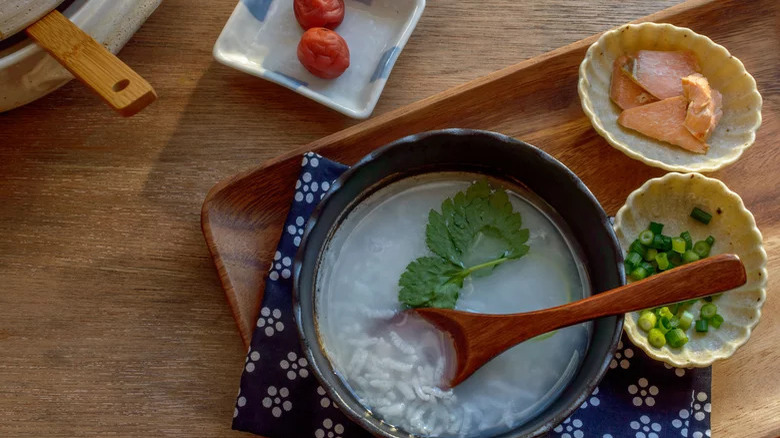
When it comes to mindful cuisine, few countries do it better than Japan. Food there isn't only for enjoyment, it takes into consideration your well-being. Okayu is a simple rice porridge dish that people eat when under the weather. It's made with rice and water and has an easily digestible consistency. "Okayu would be great when your stomach isn't feeling too good," Yuka Allen says. Along with a tender texture, it offers restorative benefits and has a neutral profile that you can flavor with countless ingredients. "I like to stir in a raw egg and cook a little with seasoning," she adds.
Toppings like nori, sesame seeds, green onion, umeboshi, grilled fish, eggs, and vegetables are common flavor boosters. Dashi or chicken stock can be used in place of water to add flavor, too. Japanese people consider okayu a healing food, though, so it's typically kept plain-ish despite having versatile potential. Because okayu is ideal for cold symptoms, it's mostly enjoyed as a Japanese winter food .
Side dishes (kobachi)
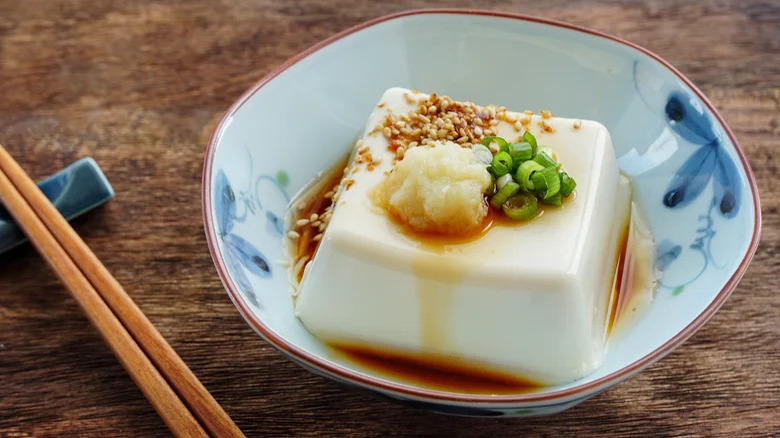
Kobachi, or "small bowl," refers to Japanese side dishes. You won't find a more impressive selection of sides than what Japan offers. Commonly sold at sushi restaurants in the United States, Japan, however, serves kobachi for breakfast as well. The word actually refers to the serving bowl itself, rather than the sides. Locals use it interchangeably, but mostly to describe the various foods. There are many types of crave-worthy kobachi, enough to keep you busy in the kitchen. The extra time it takes to prepare them is perhaps the only downside.
Yuka Allen brings up an important point: "A stay-at-home wife/mom may serve several kobachi dishes with gohan and misoshiru for better nutrition. If you are a working mom, you probably opt out of the extra steps at home and enjoy them when you are eating out or staying at hotels/inns." Nonetheless, kobachi is a popular part of breakfast in Japan. Some sides include crispy-fried lotus root, vegetable tempura, salad, pork-wrapped eggplant, and hiyayakko, which is cold tofu seasoned with soy sauce, garlic, spring onions, and other ingredients. Whether you prefer refreshing to savory or sweet to spicy, there is a kobachi for you.
Rice balls (onigiri)
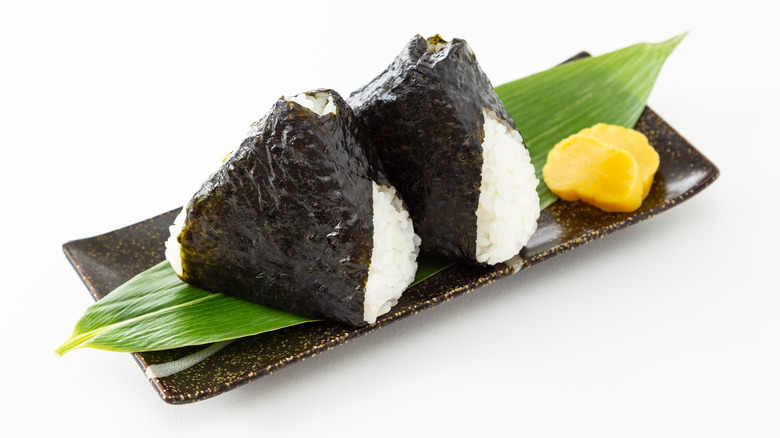
Onigiri , or rice balls, are hands-down one of the best ways to introduce someone to Japanese cuisine. They are genius culinary creations that have been satisfying stomachs for hundreds of years. More specifically, onigiri are nori-wrapped rice balls stuffed with ingredients. Fillings can range from kombu (kelp) and umeboshi to seafood, vegetables, kimchi, and much more. There's no better way to start Monday, and what's more, onigiri is super cheap and the perfect on-the-go treat. If you don't have time to cook breakfast in the morning, it's widely available at convenience stores, supermarkets, and specialty shops in pre-made and fresh forms.
"Onigiri to me is for a lunchbox, but warm, freshly made onigiri with nori wrapped around is really good for breakfast too," Yuka Allen says. To say that it's popular in Japan is an understatement. There is an onigiri location that has a 3-hour wait . Yumiko Ukon, resident Onigiri Master of Onigiri Bongo, uses inventive fillings like beef curry, bacon and cheese, fried chicken, pork kimchi, and pepperoncino. You can bring the same adventurous spirit to breakfast with bacon and eggs-stuffed onigiri.
Morning ramen (asa ramen)
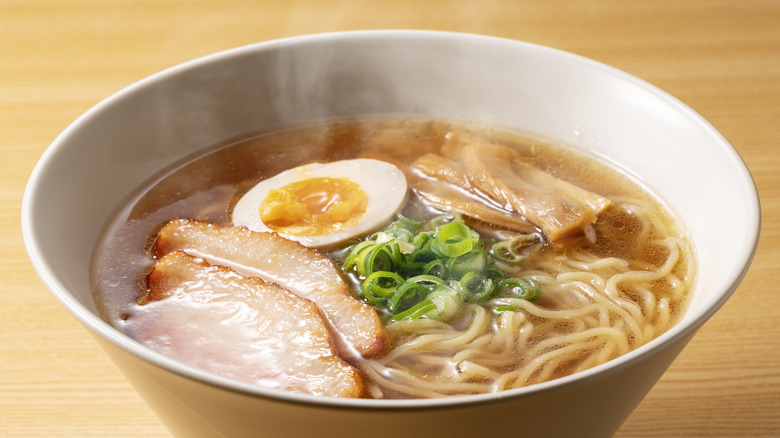
A newer breakfast trend in Japan is morning ramen, known as "asa ramen" or the short form "asa-ra." Though normally associated with lunch and dinner, morning ramen has been around for hundreds of years. It's served at restaurants as an energizing option for early-morning workers. Japan is known for having a highly intense work culture, so quick breakfast options are important. Shida ramen is the most popular breakfast style. It's named after the place where asa ramen originates, the Shida District, and is a bonito and soy sauce-based soup that includes char siu meat, served with hot and cold noodles. The soup has a subtle sweetness and comes with pickled ginger and spicy wasabi.
There are many styles of asa-ramen. Ohayo Gozaimasu style includes ingredients like bacon, avocado, tomatoes, enoki mushrooms, and poached eggs — a decidedly heartier alternative. What better incentive to get your Japanese ramen -fix for breakfast, lunch, and dinner?

African Safari
Sendai & Matsushima

More Information about African Safari
Street address.

- Car Approximately 50 minutes’ drive from Usa Jingu Shrine to African Safari (around 35.4 km)
- ・Around 9 minutes by bus from Usa Hachiman to Hokyoji (Oita Kotsu Bus, Kokudo Chuko Line for Yokkaichi City (Oita Prefecture)) ・Around 28 minutes by bus from Hokyoji to Ajimu Shisho-mae (Oita Kotsu Bus, Nakayasu Line for Ajimu) ・Around 26 minutes by bus from Ajimu Shisho-mae to Senninda-chaya (Oita Kotsu Bus, Tsubusa Line (only runs on school days) for Senninda-chaya)
Opening Hours
Best season.

Spots around

Sakuradaki Waterfall

Yufuin Hot Spring

Oka Castle Ruins

Ontayaki no Sato

Rakanji Temple

Usuki Stone Buddhas

Inazumi Underwater Cave

Kyushu OLLE (Okubungo Course)

kunisaki Peninsula Minemichi Long Trail

Beppu Jigoku Meguri (hell tour)

Beppu City Traditional Bamboo Crafts Center

Fukashima Island

Oita Airport

Usa Jingu Shrine

Nioza Historical Road

Hita Gion Yamaboko (Festival float) Hall

Geo Experience

Futago-ji Temple

Kitchom san Village Green Tourism

Kuju region

Usuki City's castle town walk (Nioza, Kani Shoyu, Kotegawa Brewery, etc.)

Hita Hot Spring

Yaba Gorge, Nakatsu (Red autumnal leaves)

Ao-no-domon Tunnel

Mameda-machi
Share this page, transportation, longer itineraries new.

Highlighting Japanese Ceramics in Tokyo and Kyushu

10 Day Sake Brewery Crawl Tour

Feeling the Mysteries of Nature in Tokyo and Kyushu

From Tokyo to Kyushu - A journey to experience the harmony between nature and culture

A journey to explore traditions and innovative culture
Top itineraries.

THE ABDITORY

ARTIFACT X VIEW

HISTORIC BEAUTY OF ARTS AND BUILDINGS

STUDY & ART

EXPERIENCE THE QUINTESSENTIAL

WATER TAXI CRUISE

FEEL THE EARTH
More itineraries.

THE GLINT OF LIGHTS ON THE WATER

HISTORY & RELIGION

RELAXATION & CULTURE

NATURE MEETS TECHNOLOGY

WILDNESS & STILLNESS

STREETS OF OLD JAPAN

REFRESHING BREEZE IN GREEN STILLNESS
Traveler reviews.

Back to Top
- Subscribe Digital Print

- Extreme heat
- Nankai Trough
- Latest News
- BOILING POINT SERIES
Today's print edition
Home Delivery
- Crime & Legal
- Science & Health
- More sports
- CLIMATE CHANGE
- SUSTAINABILITY
- EARTH SCIENCE
- Food & Drink
- Style & Design
- TV & Streaming
- Entertainment news
Shinichiro Takagi sees a way forward for fine dining in Japan

Shinichiro Takagi is proactively shaping the future of Japanese fine dining.
It’s a project Takagi believes will pay dividends for the next generation of Japan’s fine-dining stars.

“Many students do not believe they can reach Michelin-starred restaurants,” Takagi tells The Japan Times, “but I want to let them know it is possible.”
Passionate about nurturing young culinary talent, Takagi, 54, has also volunteered in elementary schools and gave lessons on food.
“The motivation was not about teaching students to be chefs but to cultivate a genuine appreciation for food,” he says. “By inspiring deeper exploration and reflection, we can foster a thriving culinary ecosystem — and I think this is great for the industry. We need not only talented chefs but also knowledgeable sommeliers , attentive service staff and appreciative customers.”
Takagi is a seasoned figure in Japan’s fine dining scene. An alumnus of Kyoto Kitcho, Japan’s leading institution for kaiseki (Japanese haute cuisine), he has honed his expertise in classical culinary techniques and led Zeniya and its menu showcasing the region’s specialty Kaga cuisine to Michelin acclaim. Last August, Takagi launched Zeniya’s first international outpost at the Shangri-La hotel in Singapore. Additionally, he serves as a Japanese Cuisine Goodwill Ambassador and Executive Chef at Taka-An, a restaurant in the Aman Kyoto resort. Takagi is also preparing to launch a casual restaurant in the U.S. state of Arkansas next year.

Takagi’s extensive international experience equips him with a unique vantage point on the future of fine dining both within and beyond Japan.
Often cited as the world’s best restaurant, Noma will be serving its last regular diners in the winter of 2024. In your opinion, is this the beginning of the end for the world’s great fine-dining restaurants?
It is not easy to make money in fine dining due to high costs. But restaurants like El Bulli and Noma represent unique business models, particularly in terms of staffing. With kitchen crews often matching the number of guests, these establishments heavily rely on a stagiaire system where many chefs work without pay. While this significantly reduces labor costs, the demanding nature of kitchen work could lead to legal challenges if unpaid young chefs raise complaints.
But renowned French restaurants such as those of Alain Ducasse and Michel Troisgros typically employ fewer stagiaires. So while it is not easy to make money in fine dining, it is not true that fine dining does not make money.
What similarities and differences have you observed between the fine-dining landscapes of Japan and other international food capitals?
Focusing on Japanese cuisine, you would observe that high-end Japanese restaurants predominantly fall into two categories: counter seating and private rooms. Ryōtei , the traditional private dining establishment, historically catered to corporate functions, but the frequency of such use has been decreasing and so has the number of ryōtei restaurants. In contrast, counter-style ryōtei, often featuring one or two chefs serving small groups, have surged in popularity as they require relatively low initial investment and labor costs.

For myself as a second-generation chef, most of the existing infrastructure came from my father’s heritage when he set up Zeniya Kanazawa in 1970. While I invest in tableware and artwork, these expenses are relatively modest. Perhaps that is why I can keep the restaurant going.
What are the main challenges confronting the fine-dining sector in Japan?
Human resource shortages are already evident. This is compounded by escalating costs for food, electricity and labor. Traditional business models that fail to generate adequate profits will not be able to continue.
And the situation is further complicated by natural disasters.
The impact brought on by natural disasters is huge. I witnessed firsthand the devastating geographic changes wrought by the 2011 Tohoku earthquake and tsunami when I volunteered in Ishinomaki. The 2024 Noto earthquake further underscored this reality. Wajima's landscape was dramatically altered within seconds, with the ground rising by four meters. The seaport could no longer be used, and that dealt a crippling blow to the fishing community, forcing many in the trade and their children to leave the industry.

Global climate change poses a growing threat to Japan's seafood-centric cuisine. Rising ocean temperatures have caused fish species, such as fugu, to migrate northward. Once predominantly found in southern Japan, they are increasingly found in Hokkaido. Overfishing is also a critical issue. Japan imposes strict regulations on bluefin tuna fishing during specific periods, which are observed by its fishing industry, but foreign fishing boats often disregard these regulations, depleting fish stocks.
What are the most notable changes the Japanese culinary landscape has observed in recent years?
The rise of female chefs is remarkable and will probably continue to increase, so it is important to provide an environment where women can work comfortably.
Evolving consumer preferences, lifestyles and business practices will change the way Japanese restaurants have been used in the past, and the ryōtei culture will face a crisis. In fact, the number of Japanese restaurants with private rooms will increasingly decrease as the value of such rooms becomes less and less.
Since the trend of more non-Japanese guests than ever before will not change, it can be considered that the market has expanded as a result, and this should be seen as a business opportunity.
News reports say international tourists spent more than ¥5 trillion (about $34 billion) in Japan last year, and over a third of that was spent on food and drink. Is that surprising?
In the late 1990s, over at Zeniya Kanazawa, we only had a few guests per month who were foreigners, but now more than 30% of our guests come from outside of Japan.

Helped by the attractiveness of the yen, more people are coming to Japan. This is especially true for starred restaurants in Tokyo, which are increasingly relying on foreigners for business. When tourists arrive, they explore a wide range of culinary options beyond fine dining and gain a deeper appreciation for Japanese cuisine.
Meanwhile, international visitors are increasingly drawn to kaiseki as a means to explore Japan's gastronomic heritage. While kaiseki is a revered tradition, it appeals to a relatively small segment of the Japanese population, perhaps only 30% to 40%. The Japanese do not have the patience to spend so many hours at the dining table.
How can Japan’s gastronomic world better prepare itself for a global audience?
The way to improve is to keep changing, developing and moving with time. It will be necessary to adapt the presentation of the cuisine to a comfortable dining environment for non-Japanese.
At Zeniya Kanazawa, we have a relatively traditional form (counter and private rooms), but Taka-An in Aman Kyoto has only tables and a counter, with no tokonoma (alcove) or hanging scrolls in its interior design.

As foreign diners become more sophisticated, we observe how, besides appreciating Japanese cuisine, there is a desire to delve deeper into the cultural aspects. Providing insights into tableware, hanging scrolls and ikebana is essential for elevating the dining experience. In the case of traditional-style private rooms like Zeniya, explaining the symbolism and artistry behind these elements can enrich guests’ understanding.
Could this pose more of a challenge for Japanese chefs than cooking?
Acquisition of English is essential to explain the concept of cuisine that is being served. But simply telling customers about the names of ingredients in English is not enough to give them a deep understanding or inspiration.
Cultivating a deeper appreciation for our cuisine among our patrons is essential. By enhancing their understanding of our culinary philosophy, we elevate our brand and, as a result, we would be better able to attract future talent.
Although preserving traditional forms and challenging new forms may seem to be in different directions, they are synonymous in preserving Japanese culinary culture for the next generation. What is important in the process of preservation is that guests from all over the world find value in Japanese cuisine and become powerful collaborators and customers.

Without a global customer base, long-term sustainability within the Japanese market alone becomes increasingly challenging. Therefore, recognizing the value of both traditional and contemporary approaches, as exemplified by Zeniya and Taka-An, is crucial for attracting and retaining a diverse clientele.
What insights have you gained about Japanese cuisine through your extensive culinary exchanges?
When I was in the States as a student in the 1980s, my peers were astonished by the Japanese custom of consuming raw fish. Fast forward a few decades and sushi has become a global phenomenon, albeit often with soft shell crab and avocado. I saw for myself how food localized and became popular. A few months ago, I was in Cape Town for a pop-up and ramen was already localized there.
Japanese cuisine has been designated by UNESCO as an intangible cultural heritage, and food has become another important platform for Japanese culture. As a chef, my mission is not only to showcase Japanese cuisine at its finest but also to deepen the global understanding of Japanese culture through authentic dining experiences.
Worldwide, sushi, tempura and ramen have achieved widespread popularity, but high-quality kaiseki are few and far in between. As I see it, kaiseki is the next big thing Japan can share with the world.
What is the unique appeal of kaiseki cuisine?
To me, kaiseki is a total art form, akin to opera, whereas sushi and ramen restaurants can be compared to solo performances. Appreciating kaiseki requires a cultivated palate and a deeper exploration of its intricacies. From meticulous ingredient selection and collaboration with producers to the artistry of presentation, kaiseki offers a profound immersion into Japanese culture.
Within a kaiseki course, the adjustments do not stop. That is why you would not see a menu on the table, whether it is at Zeniya Kanazawa or Taka-An in Aman Kyoto.

In a time of both misinformation and too much information, quality journalism is more crucial than ever. By subscribing, you can help us get the story right.

COMMENTS
Maeve joins legendary restaurateur Tetsuya Wakuda, who gives tips on the key ingredients in Japanese cooking and makes a simple marinade using just five ingr...
Yamagata Prefecture's Famous Foods. 1. Imo Nabe (Potato Stew) - This is essentially a potato nabe. Must be good though since it seems to come in at number one. 2. Tamago Konyaku (Ball Konyaku) - This is konyaku (nearly zero calories!) in the shape of balls, cooked in various ways. 3.
From sizzling street food stalls to Michelin-starred restaurants, Tokyo is a vibrant food safari where traditional dishes meet innovative cuisine. With more than 150,000 restaurants, Tokyo holds the record for the most Michelin stars in the world , underscoring its status as a food lover's paradise.
As such, the style and culture and FOOD reflect that side of the people. Let's take a deep dive into Japanese soul food. Come with our guides on an Osaka Food Safari and try local dishes, drink their sake and beer, maybe do some cooking along the way. We take you to the center of the city where many small eateries and street vendors line the ...
Japanese: With Maeve O'Meara, Tetsuya Wakuda, Kimitaka Azuma, Tosh Nishimura. Maeve O'Meara joins legendary restaurateur Tetsuya Wakuda who gives tips on the key ingredients in Japanese cuisine.
Food Safari S02 • E01 Japanese Explore the fresh flavours of Japanese food with passionate chefs and home cooks. Maeve O'Meara joins legendary restaurateur Tetsuya Wakuda who gives tips on the ...
Video Food Safari - Japanese Safari Maeve O'Meara leads a voyage of culinary discovery through the restaurants and home kitchens of Australia in a new series of Food Safari. In 13 ...
Cooking, Educational. 26m 2007 English. In Japan, sushi master Shinji Tani reveals some of the secrets of his art, and knife expert Hideo Dekura slices sashimi. Plus, five ingredient marinade ...
Food Safari explores the fresh flavours of Japanese food with passionate top chefs and home-cooks. Maeve O'Meara joins legendary restaurateur Tetsuya …
December 5, 2007. 25min. ALL. Food Safari explores the fresh flavors of Japanese food with passionate top chefs and home-cooks. Maeve O'Meara joins legendary restaurateur Tetsuya Wakuda who gives tips on the key ingredients in Japanese cooking and makes a simple marinade using just five ingredients, including his favourite miso paste.
Food Safari is an Australian television food series presented by Maeve O'Meara and produced by Kismet Productions [1] in association with SBS TV Australia, and explores the cuisines brought to Australia by its immigrants.From seasons 1 to 4, each episode covered a cuisine from a particular culture, including commonly used ingredients and where to obtain them in Australia, the preparation and ...
Food Safari explores the fresh flavors of Japanese food with passionate top chefs and home-cooks. Maeve O'Meara joins legendary restaurateur Tetsuya Wakuda who gives tips on the key ingredients in Japanese cooking and makes a simple marinade using just five ingredients, including his favourite miso paste.
In each episode of Food Safari, Maeve O'Meara visits a different cuisine, taking you into kitchens and restaurants across the nation to learn new recipes.
As a frequent diner at my local Japanese restaurant, I thought I had a pretty good grasp of the country's cuisine. But, when I had the chance to visit Japan's southernmost prefecture, the stunning islands of Okinawa, I soon realised I'd barely scratched the surface.. A prefecture of Japan since the 19th century, Okinawa was historically part of the Ryukyu Kingdom, with its culture a mix ...
No Japan food guide would be complete without a mention of sushi, which can be found in restaurants and carousels around the whole of Japan. ... Participate in a Street Food Safari in Osaka. Osaka is Japan's culinary capital and the canal district of Dotonbori is where you can find the best local delicacies. With flashing neon signs of ...
Contact Us. Food Safari takes you on a culinary journey across Australia. Producer-presenter Maeve O'Meara has spent most of her life seeking out great food, recipes and the clever people who make ...
Takoyaki is a ball-shaped Japanese snack made from wheat flour batter filled with minced or diced octopus. The ball is fried in a specialty pan and then topped with takoyaki sauce, mayonnaise, bonito flakes, pickled ginger, and green onions. It's a sweet and savory snack that will fill you up at least a little bit.
The Fuji Safari Park (富士サファリパーク) is a wildlife park on the southern slopes of Mount Fuji where visitors can take a safari through the simulated habitats of freely roaming animals, including lions, tigers, bears, giraffes, cheetahs, elephants, rhinoceroses, zebras and bison. It is one of the largest and most popular safari parks in Japan.
Food Safari - Japanese Safari Maeve joins legendary restaurateur Tetsuya Wakuda, who gives tips on the key ingredients in Japanese cooking and makes a simple marinade using just five ingredients, ...
Coffee is America's favorite morning booster, but in Japan, green tea kicks off the day. There are several varieties of Japanese green tea.Matcha, sencha, and genmaicha are a few popular types.
African Safari. Around 70 species and 1,400 animals and birds live active lives in this approximately 115 m2 expanse of nature. This safari-style zoological garden is among the largest in Japan; here, you can gain an incredible, exciting view of the wildlife in the Safari Zone, where you can see large wild animals from your car or the Jungle ...
In this episode, Maeve O'Meara explores the world of Chinese food, one of the most ancient and developed cuisines on earth. Maeve learns from Shanghai expatr...
Featuring the best in food the world has to offer, Food Safari is an enticing blend of exotic food with down to earth practicality. Tonight Maeve O'Meara vis...
Shinichiro Takagi is proactively shaping the future of Japanese fine dining. On Aug. 21, the second-generation owner of two-Michelin-starred Zeniya in Kanazawa, Ishikawa Prefecture, will take four ...
Join Maeve O'Meara as she explores the nourishing foods of Egypt and discovers the country's favourite dishes. Maeve meets chef Ramy Megalaa who introduces t...